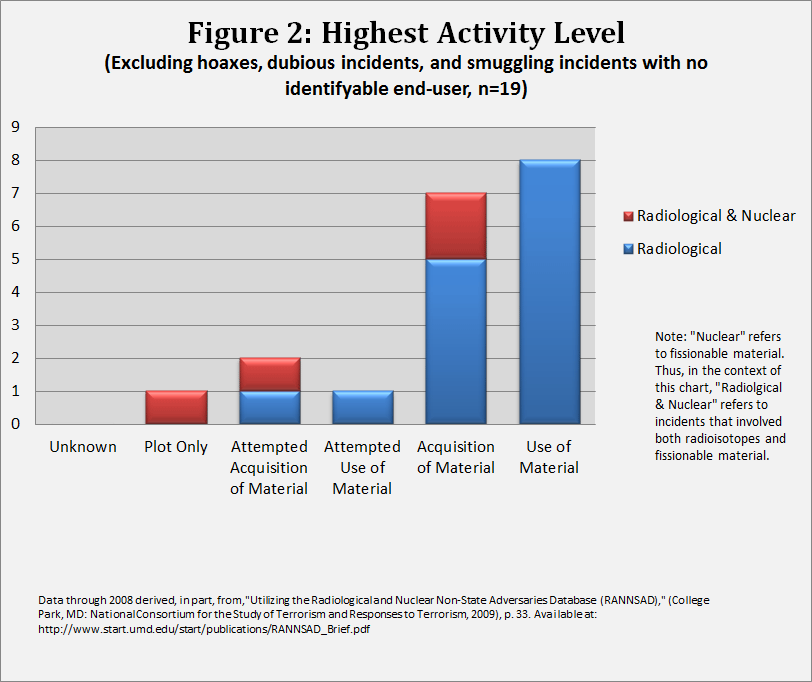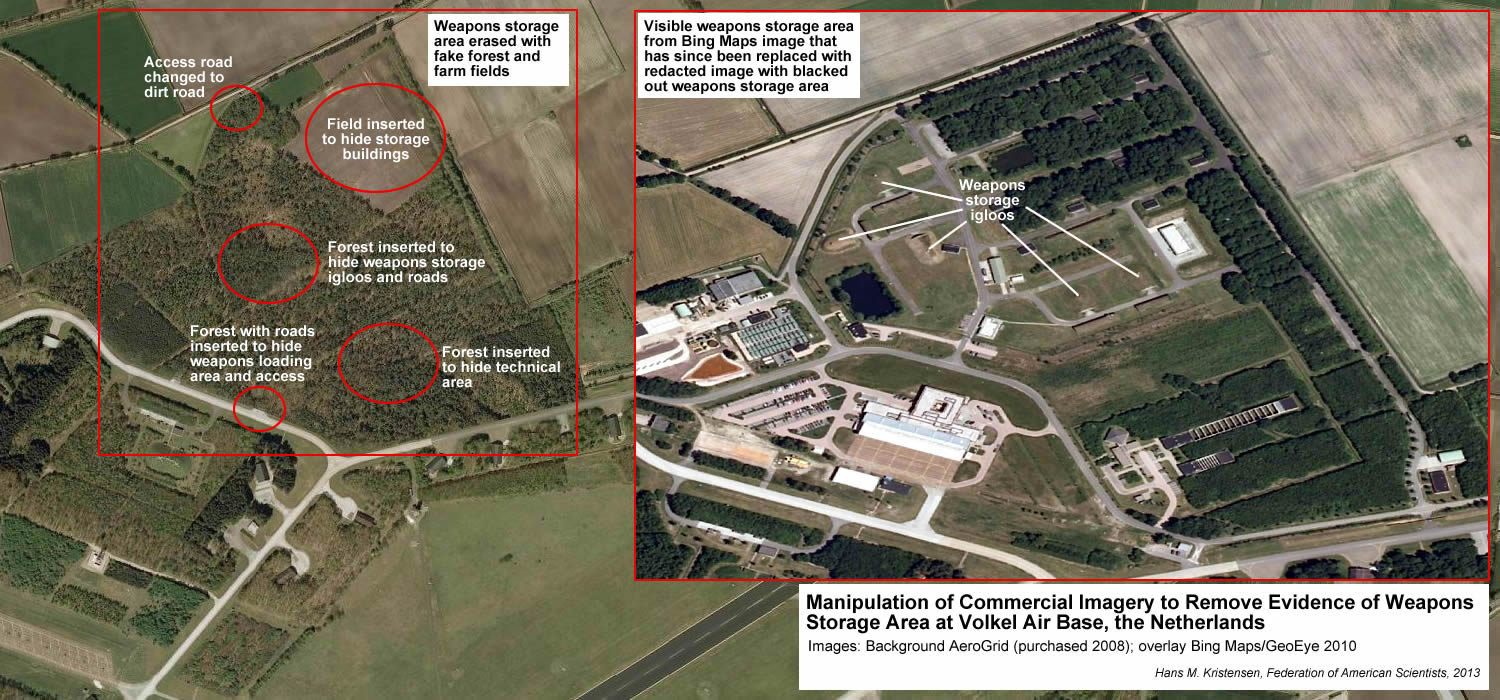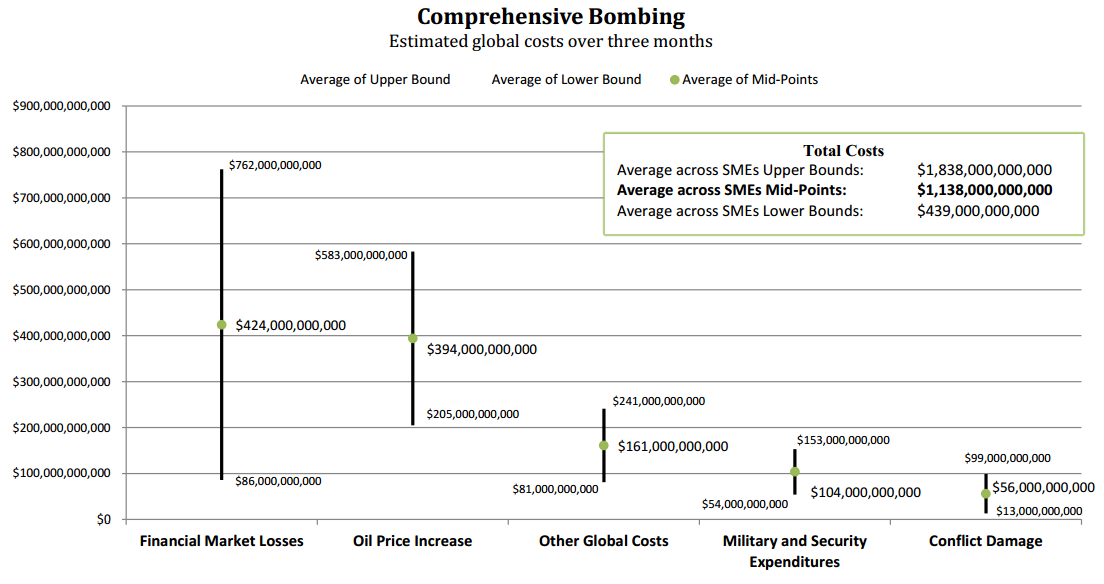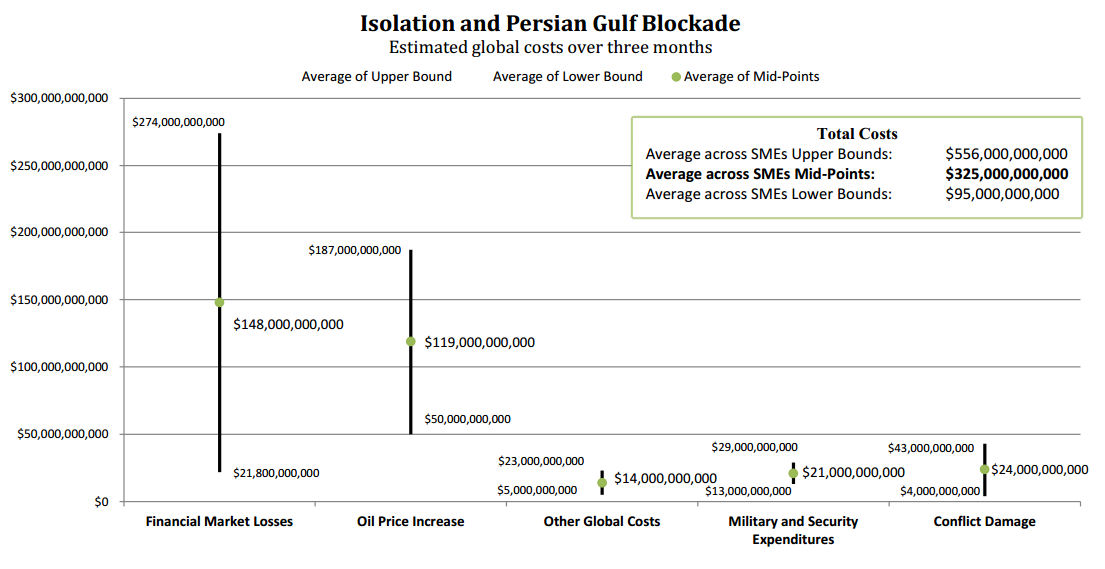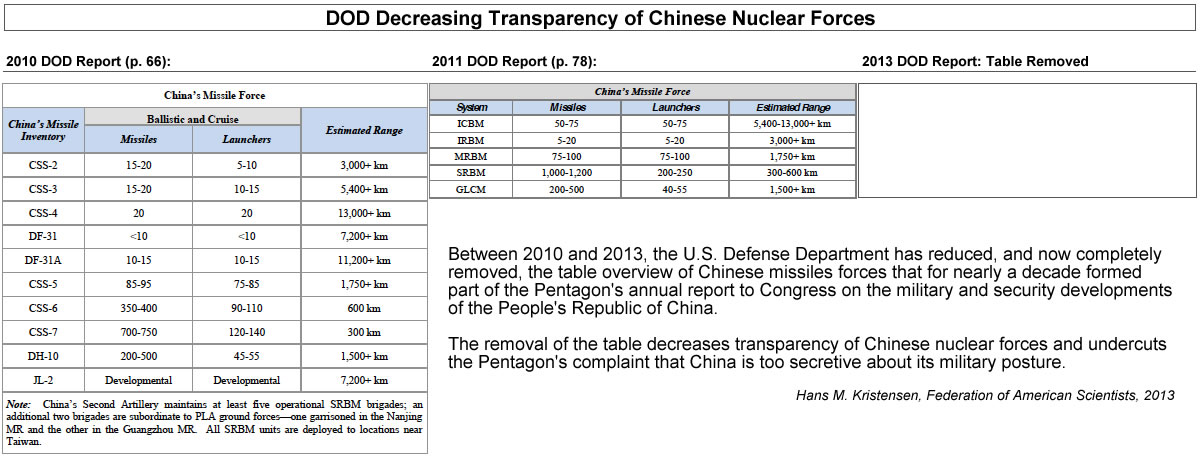Russian Missile Test Creates Confusion and Opposition in Washington
The recent test-launch of a modified Russian ballistic missile has nuclear arms reduction opponents up in arms with claims that Russia is fielding a new missile in violation of arms control agreements and that the United States therefore should not pursue further reductions of nuclear forces.
The fact that the Russian name of the modified missile – Rubezh – sounds a little like rubbish is a coincidence, but it fits some of the complaints pretty well.
Although many of the facts are missing – what the missile is and what the U.S. Intelligence Community has concluded – public information and statements indicate that the missile is a modified RS-24 Yars (SS-27 Mod 2) with intercontinental range.
Whatever the missile is, it is certainly no reason for why the United States should not seek to reduce U.S. and Russian nuclear forces further. On the contrary, the continued modernization of nuclear weapons underscores why it is important that the United States continues its push for reducing the numbers and role of nuclear weapons.
The Accusations
Under the headline “Russian Aggression: Putin violating nuclear missile treaty,” the article on Washington Times Free Beacon web site accuses Russia of being engaged in “a major violation” of the terms of the Intermediate-range Nuclear Forces (INF) Treaty signed with the United States in 1987.
The treaty bans all nuclear ground-launched ballistic and cruise missiles with range between 500 and 5,500 km (about 300-3,400 miles).
Claims of Russian cheating are frequent in the Washington arms control debate – just as claims about U.S. cheating is frequent in the Moscow arms control debate – and the ones in the article are largely consistent with the claims made by Mark Schneider, a former DOD official and now with the National Institute for Public Policy.
The “new” in the article is that it quotes “one official” saying: “The intelligence community believes it’s an intermediate-range missile that [the Russians] have classified as an ICBM because it would violate the INF treaty.” In total, “Two U.S. intelligence officials said the Yars M is not an ICBM,” according to the article.
Two members of Congress, House Armed Services Committee chairman Howard “Buck” McKeon (R-CA) and House Permanent Select Intelligence Committee chairman Mike Rodgers (R-MI), have written President Obama about alleged Russian violations. They complain that they haven’t received a response but the administration says it deals with treaty compliance issue directly with Russia and informs Congress accordingly.
Accusations Disputed
The accusations that the Yars-M is not an ICBM and in violation of the INF Treaty are disputed by Russian officials and, interestingly, previous flight tests of the missile itself.
To its credit, the Washington Times took the trouble of asking Colonel General Victor Yesin about the missile. Yesin is former Chief of Staff of the Russian Strategic Rocket Forces and apparently a consultant to the Chief of the General Staff. But Yesin clearly disputed the claim by the U.S. intelligence officials, saying that the Yars-M is a “Topol-M class ICBM” and that “its range is over 5,500 km.”
That assessment fits the description made by a source in the General Staff in November 2012, following the first Yars-M launch from Kapustin Yar in October 2012 and news media rumors that Russia was developing a “fundamentally new missile.” “There are no fundamentally new missiles ‘on the approach’ for [the Russian Strategic Rocket Forces]. We are talking about modernizing the existing Yars class by improving the warhead,” he told Interfax and explained:
“Take the Layner [modification of the SS-N-23] sea-based intercontinental ballistic missile, reported by some media to be a completely new missile. It is in fact a Sineva. Only the warhead is new. Novelty lies in greater missile defense penetration capabilities, achieved owing to, among other things, a greater number of re-entry vehicles (boyevoy blok) in the warhead. The same applies to the prototype missile that was successfully launched from Kapustin Yar (Astrakhan Region) recently. There is nothing new in the missile itself. Only the ‘head’ is new. Its creators went down the same route as the designers of the Layner.”
Moreover, the claim that the short flight range of the missile test launched from Kaputsin Yar in June 2013 would indicate that the Yars-M is not an ICBM ignores that an earlier flight test of the missile last year flew 5,800 kilometers from Plesetsk north of Moscow to the Kura test range on the Kamchatka Peninsula (see table).
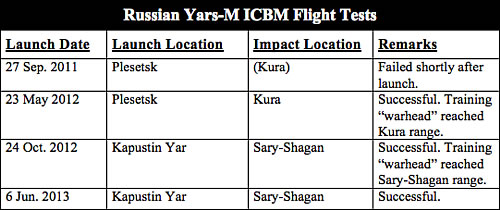
After the May 2012 flight test, Colonel-General Vladimir Zarudnitsky of the General Staff said: “As part of the approved plan of your building the armed forces of the Russian Federation last night made a promising test launch rocket system” Frontier “with an intercontinental ballistic missile high-precision shooting.” (Emphasis added).
Col. Vadim Koval, a Russian defense ministry spokesperson, said “the main goals and tasks of the launch consisted of receiving experimental data on confirming the correctness of the scientific-technical and technological decisions in developing the intercontinental ballistic missile as well as checking the performance and determining the technical characteristics of its systems and components.” (Emphasis added).
Rather than an entirely new missile, Koval explained further, “This missile is being created by using and developing, to the maximum extent, already existing new capacities and technological solutions, which were obtained in the development of fifth generation missile complexes, which substantially reduces the terms and expenditures on its creation.”
After the successful initial launch from Plesetsk, the second test was moved to Kapustin Yar apparently to test the capability of the Yars-M payload to evade ballistic missile defense systems. An industry sources told Interfax that, “The use of new fuel is one of the features of the missile. It reduces boost phase engine operation time. Consequently, the missile’s capabilities to penetrate missile defense will go up.”
It is rare, but not unheard of, that ICBMs are launched from Kapustin Yar into the Sary-Sagan test range. It appears to happen when ICBM payloads are being tested against missile defense systems. In addition to the recent tests of the modified SS-27, an SS-25 was test launched from the site on June 7, 2012. The test flight verified the “extended service life” of the SS-25 and “the latest test of an ICBM combat payload.” During the test “information was received which in future will be used in the interests of developing effective means for overcoming missile defense,” according to the Russian Ministry of Defense.
After the June 2013 test, Deputy Prime Minister Dmitry Rogozin, called the modified SS-27 a “missile defense killer.”
It is not unusual that ballistic missiles with intercontinental range are test-flown in a compressed trajectory with much shorter range. That doesn’t make them less than strategic weapons, however. In March 2006, for example, the U.S. Navy launched a Trident II D5 sea-launched ballistic missile with a range of well over 7,400 kilometer (4,000 miles) in a compressed trajectory of 2,200 kilometers (1,380 miles) – about the same range as the Yars-M test on June 6, 2013. No one has suggested that the Trident II D5 therefore is an INF weapon.
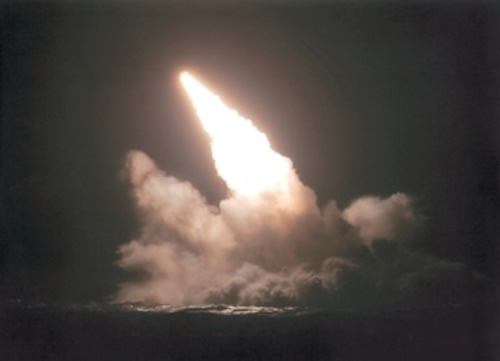
The USS Tennessee (SSBN-734) launches a Trident II D5 SLBM on March 2, 2005, on a compressed trajectory of only 2,200 km – about the same range as the Yars-M test in June 2013.
Conclusions and Recommendations
If there are Russian violations of the INF Treaty, then the United States certainly should raise it directly with Moscow.
But the claim that the Yars-M missile flight-tested on June 6 to a range of 2,050 kilometers is an intermediate-range ballistic missile in violation of the INF treaty seems strange since the same missile apparently was flight tested to an ICBM range of 5,800 kilometers just a year ago.
Of course, we don’t know who the U.S. intelligence officials cited in the Washington Times article are, if what they say is accurate, and to what extent it reflects a coordinated assessment by the U.S. Intelligence Community. We may learn more about the Yars-M in the future.
But several Russian government, military, and industry officials have consistently stated that the Yars-M is not a new missile but a modification of the RS-24 Yars (SS-27 Mod 2) and that it has intercontinental range.
The intension of the allegations in the article seems clear: to create doubts about further reductions of U.S. nuclear forces. One of the “officials” quoted in the article directly questions: “How can President Obama believe [the Russians] are going to live up to any nuclear treaty reductions when he knows they are violating the INF treaty by calling one of their missiles something else?”
The thought that Americans would use INF treaty allegations to argue against reducing the number of strategic nuclear weapons that can hit the United States seems kind of bizarre. After all, under current Russian war plans, many of the 400-500 warheads President Obama has proposed can be offloaded under a new agreement, are most likely currently tasked to hold at risk several hundred targets in the United States – including some in California and Michigan.
Since Russia – unlike the United States – is already below the New START Treaty limit on deployed nuclear weapons and likely to drop further before the treaty enters into force in 2018, it seems like a no-brainer that it is in the U.S. interest to nurture that trend by reducing its own forces further.
This is even more important because the very reason some Russian officials could potentially be tempted to argue that an INF-missile was needed is that China is modernizing of its medium-range missile forces. Ironically, many of those in the United States who make the accusations about Russian INF violations are the same people who also warn about China’s nuclear modernization.
What the article completely seems to miss is that the only way that China and smaller nuclear weapons states may be persuaded to place limits on their nuclear arsenals is if the United States and Russia take bold steps to reduce their still enormous nuclear arsenals. Why then nitpick about dubious INF accusations to block that from happening?
This publication was made possible by grants from the New-Land Foundation and Ploughshares Fund. The statements made and views expressed are solely the responsibility of the author.
New Nuclear Weapons Employment Guidance Puts Obama’s Fingerprint on Nuclear Weapons Policy and Strategy
President Barack Obama’s Berlin speech failed to capture the nuclear disarmament spirit of the Prague speech four years ago. And no wonder. Back then Obama had to contrast with the Bush administration’s nuclear policies. This time Obama had to upstage his own record.
The only real nuclear weapons news that was included in the Berlin speech was a decision previously reported by the Center for Public Integrity that the administration is pursuing an “up to a one-third reduction” in deployed nuclear weapons established under New START.
Instead, the real nuclear news of the day were the results of the Obama administration’s long-awaited new guidance on nuclear weapons employment policy that was explained in a White House fact sheet and a more in-depth report to Congress.
From a nuclear arms control perspective, the new guidance is a mixed bag.
One the one hand, the guidance directs pursuit of additional reductions in deployed strategic warheads and less reliance on preparing for a surprise nuclear attack. On the other hand, the guidance reaffirms a commitment to core Cold War posture characteristics such as counterforce targeting, retaining a triad of strategic nuclear forces, and retaining non-strategic nuclear weapons forward deployed in Europe.
Pursue Additional Reductions
The top news is that the administration has decided that it can meet its security obligations with “up to one-third” fewer deployed strategic warheads that it is allowed under the New START treaty. That would imply that the guidance review has concluded that the United States needs 1,000-1,100 warheads deployed on land- and sea-based strategic warheads, down from the 1,550 permitted under the New START treaty.
It is not entirely clear from the public language, but it appears to be so, that these additional reductions will be pursued in negotiations with Russia rather than as reciprocal unilateral reductions.
Even though the nuclear weapons employment policy would allow for reductions below the New START Treaty levels, it does not direct any changes to the currently deployed forces of the United States. That is up to the follow-on process of the Secretary of Defense producing an updated Nuclear Weapons Employment Policy (NUWEP) appendix to the Guidance for the Employment of the Force (GEF), and the Chairman of the Joint Chiefs of Staff then producing an update to the nuclear supplement to the Joint Strategic Capabilities Plan (JSCP-N).
These updates will inform the Commander of STRATCOM on how to direct the Joint Functional Component Command Global Strike (JFCC-GS) to update the strategic war plan (OPLAN 8010-12), and Geographic Combatant Commanders such as the Commander of European Command to update their regional plans.
So if an when Russia agrees to cutting its deployed strategic warheads by up to one third, it could take several years before President Obama’s guidance actually affects the nuclear employment plans.
Already now, many news articles covering the Berlin speech misrepresent the “cut” by saying it would reduce the U.S. “arsenal” or “stockpile” by one third. But that is not accurate. The envisioned one-third reduction of deployed strategic warheads will not in and of itself destroy a single nuclear warhead or reduce the size of the bloated U.S. and Russian nuclear arsenals.
Reduce Launch Under Attack
The new guidance recognizes, which is important although late, that the possibility of a disarming surprise nuclear attack has diminished significantly since the Cold War. Therefore, the guidance “directs DoD to examine further options to reduce the role of Launch Under Attack plays in U.S. planning, while retaining the ability to Launch Under Attack if directed.”
Launch under attack is the capability to be able to launch nuclear forces after detection that an adversary has initiated a major nuclear attack. Because it only takes about 30 minutes for an ICBM to fly from Russia over the North Pole, Launch Under Attack (LOA) has meant keeping hundreds of weapons on alert and ready to launch within minutes after receiving the launch order.
Barack Obama promised during his election campaign in 2007 that he would work with Russia to take nuclear weapons off “hair-trigger alert,” but the Nuclear Posture Review instead decided to continue the existing readiness of nuclear forces. Now the DOD is directed to study how to reduce LOA in nuclear strike planning but retain some LOA capability.
The guidance does not explicitly say – to the extent it is covered by the DOD report – that nuclear force will be retained on alert. The NPR makes such a statement clearly. The DOD guidance report only states that the practice of open-ocean targeting should be retained so that a weapon launched by mistake would land in the open ocean.
Despite the decision to reduce deployed strategic warheads and reduce Launch Under Attack, the guidance hedges against the change by stating that “the maintenance of a Triad and the ability to upload warheads ensures that, should any potential crisis emerge in the future, no adversary could conclude that any perceived benefits of attacking the United States or its Allies and partners are outweighed by the costs our response would impose on them.”
Counterforce Reaffirmed
The new guidance reaffirms the Cold War practice of using nuclear forces to hold nuclear forces at risk. According to the DOD summary, the new guidance “requires the United States to maintain significant counterforce capabilities against potential adversaries” and explicitly “does not rely on a ‘counter-value’ or ‘minimum deterrence’ strategy.”
This reaffirmation is perhaps the single most important indicator that the new guidance fails to “put and end to Cold War thinking” as envisioned by the Prague speech.
Because “counterforce is preemptive or offensively reactive,” in the words of a STRATCOM-led study from 2002, reaffirmation of nuclear counterforce reaffirms highly offensive planning that is unnecessarily threatening for deterrence to work in the 21st Century. This condition is exacerbated because the reaffirmation of counterforce is associated with a decision to retain – albeit at a reduced level – the ability to Launch Under Attack if directed (see below).
The “warfighting” nature of nuclear counterforce drives requirements for Cold War-like postures and technical and operational requirements that sustain nuclear competition between major nuclear powers at a level that undercuts efforts to reduce the role and numbers of nuclear weapons.
No Sole Purpose…But
Four years after the Nuclear Posture Review decided that the United States could not adopt a sole purpose of nuclear weapons to deter only nuclear attacks, the new guidance reaffirms this rejection by saying “we cannot adopt such a policy today.”
Even so, the guidance apparently reiterates the intention to work towards that goal over time. And it directs the DOD to undertake concrete steps to further reducing the role of nuclear weapons.
Non-Strategic Nuclear Weapons
The decisions regarding non-strategic nuclear weapons are disappointing because they fail to progress the issue. In fact, the White House fact sheet explicitly states that the guidance review did not address forward deployed non-strategic nuclear weapons in Europe.
Even so, the guidance decides to retain a forward-based posture in Europe until NATO agrees it is time to change the posture. The last four years have shown that NATO is incapable of doing so because a few eastern NATO countries cling to Cold War perceptions about nuclear weapons in Europe that blocks progress.
In effect, the lack of initiative now means countries like Lithuania now effectively dictate U.S. policy on non-strategic nuclear weapons.
Hedging Against Hedging
The guidance also directs that the United States will continue to retain a large reserve of non-deployed warheads to hedge against technical failures in deployed warheads.
This both means enough extra warhead types within each leg to hedge against another warhead on that leg failing, as well as keeping enough extra warheads for each leg to hedge against failure of one of the warheads on another leg.
Now that warhead life-extension programs are underway, the guidance directs that DOD should only retain hedge warheads for those modified warheads until confidence is attained. This is a little cryptic because why would the DOD not do that, but the intension seems to be to avoid keeping the old hedge warheads longer than necessary.
Moreover, the guidance also states that all of the hedging against technical issues will provide enough reserve warheads to allow upload of additional warheads – including those removed under the New START Treaty – in response to a geopolitical development somewhere in the world.
This all suggests that we should not expect to see significant reductions in the hedge in the near future but that much of the current hedging strategy will be in place for the next decade and a half.
Conclusions
The Obama administration deserves credit for seeking further reductions in nuclear forces and the role of Launch of Warning in nuclear weapons employment planning. A White House fact sheet and a DOD report provide important information about the new nuclear weapons employment guidance, a controversial issue on which previous administrations have largely failed to brief the public.
The DOD’s report on the new guidance reiterates that it is U.S. policy to “seek the peace and security of a world without nuclear weapons,” but helpfully reminds that “it is imperative that we continue to take concrete steps toward it now.” This is helpful because Obama’s recognition in Prague that the goal of a world free of nuclear weapons might not be achieved in his lifetime has been twisted by opponents of reductions and disarmament to mean an affirmative “not in my lifetime!”
The guidance directs that nuclear “planning should focus on only those objectives and missions that are necessary for deterrence in the 21st century.” The force should be flexible enough, the guidance says, to be able to respond to “a wide range of options” by being able to “threaten credibly a wide range of nuclear responses if deterrence should fail.”
Unfortunately, the public documents do not shed any light on what those objectives and missions are or which ones have been deemed no longer necessary.
Instead, the official descriptions of the new guidance show that its retains much of the Cold War thinking that President Obama said in Prague four years ago that he wanted to put an end to. The reaffirmation of nuclear counterforce and retention of nuclear weapons in Europe are particularly disappointing, as is the decision to retain a large reserve of non-deployed warheads partly to be able to reverse reductions of deployed strategic warheads achieved under the New START Treaty.
In the coming months and years, these decisions will likely be used to justify expensive modernizations of nuclear forces and upgrades to nuclear warheads that will prompt many to ask what has actually changed.
Background: US Nuclear Forces, 2013 – Russian Nuclear Forces, 2013 – Reviewing Nuclear Guidance – From Counterforce to Minimal Deterrence
This publication was made possible by grants from the New-Land Foundation and Ploughshares Fund. The statements made and views expressed are solely the responsibility of the author.
Radiological Ray Gun: More Buck Rogers Fantasy than Risk to Real People
The June 18th arrest of two men for allegedly plotting to build a bizarre yet potentially deadly radiological device once again highlights the potential nexus of non-state actors with so-called weapons of mass destruction (WMD). However, much like this year’s troika of ricin-laced letters addressed to government facilities (including one to the CIA) and public officials (all three incidents targeted President Obama at his White House address), this most recent plot reveals the historical rarity and non-lethality of non-state actors and their behaviors with radiological weapons and agents. While the potential for catastrophe posed by terrorist use of chemical, biological, radiological, and nuclear (CBRN) weapons deserves ongoing and serious attention, recent events remind us how public apprehension is sometimes founded more in fear than reality; indeed, reactions based on fear are capable of far more disruption than the physical reality of the event itself. The role of science-based organizations such as the Federation of American Scientists is to educate the public about the real risks. [box border=”full”]The methodologies and data sets used in this article, augmented by several others of each, will be discussed in a two day professional education summer course, “Terrorism Analysis: Quantitative and Qualitative Research Methodologies and Tools” held at George Mason University in Fairfax, VA on July 25-26, 2013. This non-credit course introduces participants to state-of-the art analytical techniques, research methods, and cutting-edge databases used by the industry for the study of terrorism. Course participants gain a detailed understanding of single and multi-methodological techniques, learning how to develop analytical tools applicable to the needs of those responsible for preventing, preparing, responding to, or predicting terrorism. Highlights include how to use these research techniques to identify previous and emerging trends in terrorist activities and to cogently assess the potential role of WMD in terrorism. Register now for the “early bird” discount – 25 percent less than the listed fee. For more information and to register, please visit the course page.[/box]
Of the CBRN threats, the nuclear threat is undoubtedly truly catastrophic because a nuclear weapon can cause massive destruction, but obtaining a nuclear weapon or the fissile material to make such a weapon is very hard to do. In comparison, radiological sources are far more common, but most of them would cause little or no harm to human health if dispersed by a radiological weapon because there is not enough radioactive material contained in the vast majority of each of these sources. And even those radiological sources containing highly radioactive materials would pose great difficulties for terrorists to use because they would hazard exposing themselves to lethal ionizing radiation. These latter issues, and others outlined below, are very relevant to the recent radiological plot.
According to Tuesday’s radiological- related FBI affidavit, Glenford Scott Crawford, an industrial mechanic who reportedly self-identified as a member of the Ku Klux Klan, plotted to build “a mobile, remotely operated, radiation emitting device capable of killing human targets silently and from a distance with lethal doses of radiation.” Crawford, along with Eric J. Freight, an electronics specialist, allegedly succeeded in constructing a “remote initiation device,” but according to the FBI’s affidavit had not yet “weaponized” the device before their arrest. Monitored by the FBI since April 2012, the duo never obtained a radiological source for their device.
While the affidavit lacks a definitive answer on whether or not Crawford and Freight sought to craft a device that would emit x-rays or were trying to obtain a radioactive source to emit radiation, it appears likely that the former is the case. Significant differences exist between an x-ray emitting device and a radioactive source that emits gamma radiation. The first distinction is that an x-ray device needs electrical power to work but a radioactive source is always “on” and emitting radiation due to the natural process of radioactive decay. The other salient distinction is that if Crawford and Freight had sufficient electrical power they could—in principle—have a device capable of emitting potent radiation from a relatively far off distance— such as several meters. That is, the output of the x-ray device would depend on the electrical power available. In contrast, a radioactive source would not be able to boost its potency with the use of electrical power because the potency depends on the properties of the radioisotope and the natural process of decay.
Active in two small towns near Albany, New York, over the past year, Crawford and Freight unwittingly dealt with at least one FBI planted “confidential human source” who posed as a potential financer of the project and buyer of the finished device. Tuesday’s arrests came as the suspects, “planned to conduct a test-run of the triggering system.”
Contrary to public perceptions of radiological weapons, or “dirty bombs,” as weapons of mass destruction, experts correctly note that radiological attacks could not produce mass destruction or mass casualties. This is because when dispersed the radioactive material would be spread out over a wide area and thus would be far less potent than material concentrated in the original source. Moreover, trying to use the original source as a lethal means of exposing large numbers of people from a distance would be hard to do because the potency of the ionizing radiation would decrease the farther the source is from the targeted population. Specifically, it would decrease as one divided by the distance squared. For example, an unshielded source that is lethal at one-meter distance would have a potency of one one-hundredth when the source is ten meters away and would not likely pose a lethal threat.
Thus, the reality is that radiological devices are “weapons of mass disruption” – likely to directly generate few, if any, immediate casualties via ionizing radiation, yet capable of precipitating mass panic and large-scale economic disruption.
Similarly, belying public apprehension of radiological terrorism, there is the extreme rarity of such events; indeed, terrorist use of harmful radioisotopes, according to open-source data, numbers no more than three incidents—none of which generated casualties. If other non-state actors are included, those not considered terrorists, but include, for example, lone actors seeking revenge, recorded radiological incidents are more numerous, but still strikingly rare. A finding from a 2009 study—conducted by a University of Maryland (UMD) research team that included this author, combined with research into radiological events occurring subsequent to the studies completion—reveals only 19 recorded radiological incidents by non-state actors. (Maintaining harmony with the UMD study, the criteria for inclusion excluded hoaxes and “clear cases of smuggling or transfer activity with no apparent links to end-users.”)
Taking a brief pause, here are some basic nuclear physics useful when putting this event in the proper context. The entire universe consists of less than 120 elements; 92 are naturally occurring. Each element contains a unique number of protons. While their number of protons remains the same, some elements possess different numbers of neutrons. These are called isotopes. With neutrons in greater quantity than those found in lead and bismuth, are isotopes prone to natural decay. Such unstable isotopes are referred to as radioisotopes, which undergo decay in one of three ways: alpha, beta, or gamma decay. Depending on the rate of decay and the other factors, less than a dozen radioisotopes pose serious health risks.
Easily blocked from entering the human body, alpha emitting radioisotopes pose a health risk via inhalation or ingestion. Beta particles possess greater penetrating power, yet these can be blocked by thin layers of lead or other dense materials. It is gamma particles that pose the greatest health risk via exposure. The device Crawford and Freight sought—“a radiation emitting device that could be placed in the back of a van to covertly emit ionizing radiation strong enough to bring about radiation sickness or death against Crawford’s enemies,” required a radiological source emitting high-energy gamma rays.
States long ago foresaw radiological weapons as ineffective for battlefield use—easily obviated by many conventional and unconventional weapons. As early as 1943, notes Robert S. Norris in his 2002 book Racing for the Bomb, the “impending invasion of Europe precipitated fears and concerns about possible German use of radioactive materials on Allied forces.” U.S. scientists investigated the threat. They concluded, Norris writes, “that there would be many difficulties in devising munitions that would effectively deliver radioactive materials…” Still, Norris explained to this author on June 20, 2013, “Even in the early 1940s the fear of radioactivity was enough to move Allied planners to equip some D-Day soldiers with dosimeters.” Thankfully, Nazi Germany did not develop radiological weaponry and although serious consideration was given to their potential development (including the United States), no open-source data exists of any state having done so with the exception of one incident. The November 2006 death of Alexander Litvinenko, occurring three weeks after the former Russian Federal Security Service (FSB) officer drank tea containing polonium-210 (Po-210) in a London restaurant, was likely the work of Russian state operatives.
Non-state actors, in contrast, sometimes perceive harmful radioisotopes as an effective means towards achieving their goals. With regard to four possible perpetrator types, of the 19 recorded incidents, lone-actors account for ten. Four incidents are attributed to formal organizations and two to unaffiliated cells. Unknown perpetrator types account for three incidents.
Figure 1 demonstrates the variety of general ideologies adhered to by the perpetrators. Note that the most active of all individuals and groups with “Religious” and “Personal / Idiosyncratic” ideologies were Sunni Islamists and U.S. right-wing extremist respectively.
Figure 2 reveals how far along groups and individuals got on the spectrum of radiological activity. As noted in the UMD study, perpetrators successful in acquisition of radioisotopes more likely than not used the materials, although “success” came in only five of the incidents (assuming operational objectives that included generating casualties). The data set used to compile the previously mentioned UMD study—the Radiological and Nuclear Non-State Adversaries Database (RANNSAD)—when enlarged by this author’s subsequent research, reveals the following: four incidents that each resulted in one injury. A fifth incident, involving the use of iridium-192 (Ir-192) by a “nuclear medical researcher” in Guangzhou, China, sickened 75 individuals. When correctly excluding the death of Alexander Litvinenko, noted earlier as likely due to state actions, radiological incidents writ large have yet to yield a single fatality.
Some radioisotopes pose an extreme risk. One case of inadvertent dispersal—the 1988 Goiânia, Brazil, incident—killed four and negatively affected thousands. For well over a decade experts have warned of the likelihood of terrorist use of radioisotopes (almost half the expert respondents in a seminal 2005 survey “judged the risk of such an attack [occurring in the next ten years – i.e. by 2015] as 50 percent or greater”). Explaining non-use is akin to proving a negative—impossible. The latest incident, as farcical as elements of it may seem, should serve as a reminder that, despite a paucity of incidents and no fatalities, non-state actors continue to plot and actualize the nefarious use of radioisotopes.
Nukes in Europe: Secrecy Under Siege
By Hans M. Kristensen
 The Cold War practice of NATO and the United States refusing to confirm or deny the presence of nuclear weapons anywhere is under attack in Europe. This week, two former Dutch prime ministers publicly confirmed the presence of nuclear weapons at Volkel Air Base in the Netherlands, one of six bases in NATO that still host US nuclear weapons.
The Cold War practice of NATO and the United States refusing to confirm or deny the presence of nuclear weapons anywhere is under attack in Europe. This week, two former Dutch prime ministers publicly confirmed the presence of nuclear weapons at Volkel Air Base in the Netherlands, one of six bases in NATO that still host US nuclear weapons.
The first confirmation came in the program How Time Flies on the Dutch National Geographic channel where former prime minister Ruud Lubbers confirmed that there are nuclear weapons at Volkel Air Base. “I would never have thought those silly things would still be there in 2013,” Lubbers said, who was prime minister in 1982-1994. He even mentioned a specific number: 22 bombs.
 The second confirmation Lubbers was joined yesterday by another former Dutch prime minister, Dries van Agt, who also confirmed that the weapons are there. “They are there and its crazy they still are,” said va Agt, who was prime minister in 1977-1982.
The second confirmation Lubbers was joined yesterday by another former Dutch prime minister, Dries van Agt, who also confirmed that the weapons are there. “They are there and its crazy they still are,” said va Agt, who was prime minister in 1977-1982.
As readers of this blog are aware (and anyone who have followed this issue over the years), it is not news that the US stores nuclear weapons at Volkel AB. But it is certainly news that two former Dutch prime ministers are now confirming it.
It is not a formal Dutch break with NATO nuclear secrecy norms but it is certainly a big crack in the dike that makes the Dutch government’s continued refusal to confirm or deny nuclear weapons at Volkel AB look rather, well, silly.
The instinct of the bureaucracy will be to ignore the statements to the extent possible and retreat into past policies of neither confirming nor denying the presence of nuclear weapons. But the new situation also presents an opportunity to break with the past and attempt to engage Russia about increasing the transparency of non-strategic nuclear weapons in Europe.
Privileged Information
Information about US nuclear weapons at Volkel AB is privileged information that Lubbers and van Agt would have had access to on a highly confidential basis as prime ministers under the bilateral US-Dutch nuclear weapons storage agreement code named Toy Chest (no pun intended).
After leaving office, Lubbers and van Agt would have had to rely on other people with access to such information to be told. A nod would be sufficient to confirm the general presence of weapons, but the specific number would be harder to get. Why Lubbers says 22 is unclear; perhaps that’s the number he recalls from 1994.
Back then, the Clinton administration’s 1994 Nuclear Posture Review decided to retain 480 nuclear bombs in Europe. How many of those were at Volkel AB is unknown, but when President Clinton six years later in December 2000 signed Presidential Decision Directive/NSC-74 that authorized continued deployment of 480 nuclear weapons in Europe, 20 of those were for Volkel AB.
Since then, the United States has unilaterally reduced the stockpile in Europe by nearly 60 percent from 480 to nearly 200 bombs today. Whether the number at Volkel AB has remained the same is unknown. The base has 11 underground storage vaults inside Protective Aircraft Shelters that can house a maximum of 44 bombs (see image). The 22 bombs that Lubbers mentions would imply each vault carries two bombs, but it is probably unlikely that there are more weapons in the Volkel vaults today than in 2000.
Silly Dutch Secrecy
Getting basic information about the nuclear weapons at Volkel AB is not the only obstacle to nuclear transparency. Even aerial photos of the base are secret. For example, anyone who has tried to view Volkel AB on Google Earth will know that you can’t; the base has been completed pixel’ed out (see image below).

The reason is, the Dutch ministry of defense told me, that an old Dutch law requires that all military and royal (go figure!) facilities be obscured on aerial photos. And because the images covering the Netherlands on Google Earth are supplied by Aerodata International Surveys, a company partly based in Utrecht, the images are sanitized before handed over to Google Earth. It is a pity that a company such as Google lets itself be subjected to silly secrecy by accepting sanitized images on Google Earth.
The law is silly because all national-level adversaries (to Holland) have their own satellite imaging capabilities, so pixel’ing out Volkel AB won’t deny them any information. And anyone else can simply buy high-resolution satellite imagery on the Internet.
To test this point, I went to the web site of AeroGRID, a company partially owned by Aerodata (!). Armed only with a credit card, I was able to purchase a high-resolution image of Volkel Air Base that appeared to show the entire base (see image below).
Problem solved? Not quite. After a closer examination, I discovered that even this “clean” image had also been manipulated, even though AeroGRID never told me that the product I had paid for was actually a fake. Someone had very carefully erased a weapon storage area at the northern part of Volkel AB by overlaying it with trees and farm fields – even inserted forest roads that appear to meet up with dead-end access roads that would otherwise give away that the image had been altered.
Despite these efforts of silly secrecy, I was able to find the secret weapon storage area on another photo that was available on Bing Maps. That photo clearly showed the secret weapons storage area. By overlaying the area from the Bing Maps image onto the AeroGRID image, one can better see the extent of the image manipulation (see image below).
The secret weapons storage area is also visible on a Dutch military base map from 1999 that shows the layout of storage buildings and access roads. Comparison of the map with the Bing Maps image, however, also reveals that the weapons storage loading area has been upgraded significantly (see image below).
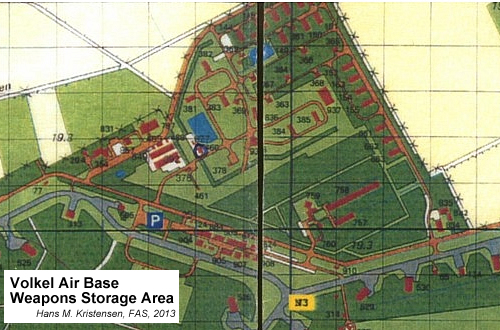
This un-redacted image is no longer available on Bing Map, however. Instead, on the new photo that is now available – yes, you guessed it – the weapons storage area has been deleted (see image below).
So why is the weapons storage area at Volkel AB secret? The facility was probably used to store the nuclear weapons until the underground vaults were added to the Protective Aircraft Shelters in 1991. But since then the weapons have been in the vaults. Perhaps they are sometimes serviced in the weapons storage area, or perhaps it’s simply a weapons storage area and therefore automatically considered secret. But now that we know that the weapons storage area is there and what it looks like, there is no need to manipulate the images anymore.
Implications and Conclusions
The confirmation by two former Dutch prime ministers that nuclear weapons are present at Volkel AB is an important contribution to increasing nuclear transparency in Europe. Although it doesn’t tell us something we don’t know, it challenges NATO’s long-standing, outdated, and counterproductive policy of keeping nuclear weapons locations secret. Germany has also confirmed that it hosts nuclear weapons.
Instead of trying to hush things up and continue the secrecy, the Dutch and German governments should together with NATO use the disclosures as an opportunity to reach out to Russia and propose a limited but reciprocal declaration of nuclear weapons storage at Volkel AB, Büchel AB in Germany, and one or two Russian bases. A declaration could be accompanied by verification of the absence of nuclear weapons from one or two bases in each country where nuclear weapons have been removed. Doing so could help jump-start the process of increasing transparency of non-strategic nuclear weapons in Europe, a goal NATO and the Dutch and German governments say they favor. Russia might be interested in exploring such an initiative.
Of course, such a transparency initiative will require the national leadership to twist the arms of the bureaucrats who will oppose any change. But incremental micromanagement of nuclear status quo in Europe will not move the ball forward; it requires political vision and leadership.
Continuing the nuclear secrecy no longer serves a beneficial purpose. The secrecy is not needed for safety or national security; those needs are taken care of by guards, guns, gates, and overall military and political postures. Instead, the secrecy fuels mistrust and rumors that lock NATO and Russia into old mindsets, postures, and relations. The secrecy is also used to chill a public debate that could otherwise result in a demand to withdraw the nuclear weapons from Europe.
One particularly controversial issue that faces the Dutch government and parliament in the next few years is that the B61 bombs at Volkel AB within the next decade are scheduled to be replaced with an improved nuclear bomb that is equipped with a new guidance tail kit that increases the weapon’s accuracy and gives it a standoff capability.
The combination of the new guided standoff B61-12 bomb and the stealthy F-35A Joint Strike Fighter – that the Dutch air force plans to get to replace the F-16 that currently has the nuclear strike mission – will significantly increase the nuclear capability at Volkel AB.
Why does the Dutch government believe it is necessary to begin deploying new guided standoff nuclear weapons at Volkel AB? How will that support the efforts to reduce the numbers and role of nuclear weapons in Europe? How will that help persuade Russia to reduce its non-strategic nuclear weapons?
It would be smart for the Dutch parliament to try to get answers to these questions from the government before the new nuclear bombs and stealth bombers start arriving at Volkel AB.
Background: Non-Strategic Nuclear Weapons (FAS 2012) | US Tactical Nuclear Weapons in Europe, 2011 (BAS 2011) | US Nuclear Weapons in Europe (NRDC 2005)
This publication was made possible by grants from the New-Land Foundation and Ploughshares Fund. The statements made and views expressed are solely the responsibility of the author.
SIPRI Yearbook 2013 Published
The Swedish International Peace Research Institute (SIPRI) today published the 2013 issue of the SIPRI Yearbook. I’m coauthor of the chapter on worldwide nuclear weapons arsenals.
The yearbook is translated into Arabic, Chinese, Russian and Ukrainian, providing a unique source of nuclear weapons information to regions where such information is either not available or only to English-speaking readers.
In addition to the annual SIPRI Yearbook, bimonthly updates of individual nuclear weapon states are published as Nuclear Notebooks in the Bulletin of the Atomic Scientists.
Moreover, an online table of world nuclear forces is provided on the FAS web site. The table is updated as new information becomes available.
Finally, occasional issue reports are published on the FAS Strategic Security Blog.
This publication was made possible by grants from the New-Land Foundation and Ploughshares Fund. The statements made and views expressed are solely the responsibility of the author.
Air Force Briefing Shows Nuclear Modernizations But Ignores US and UK Programs
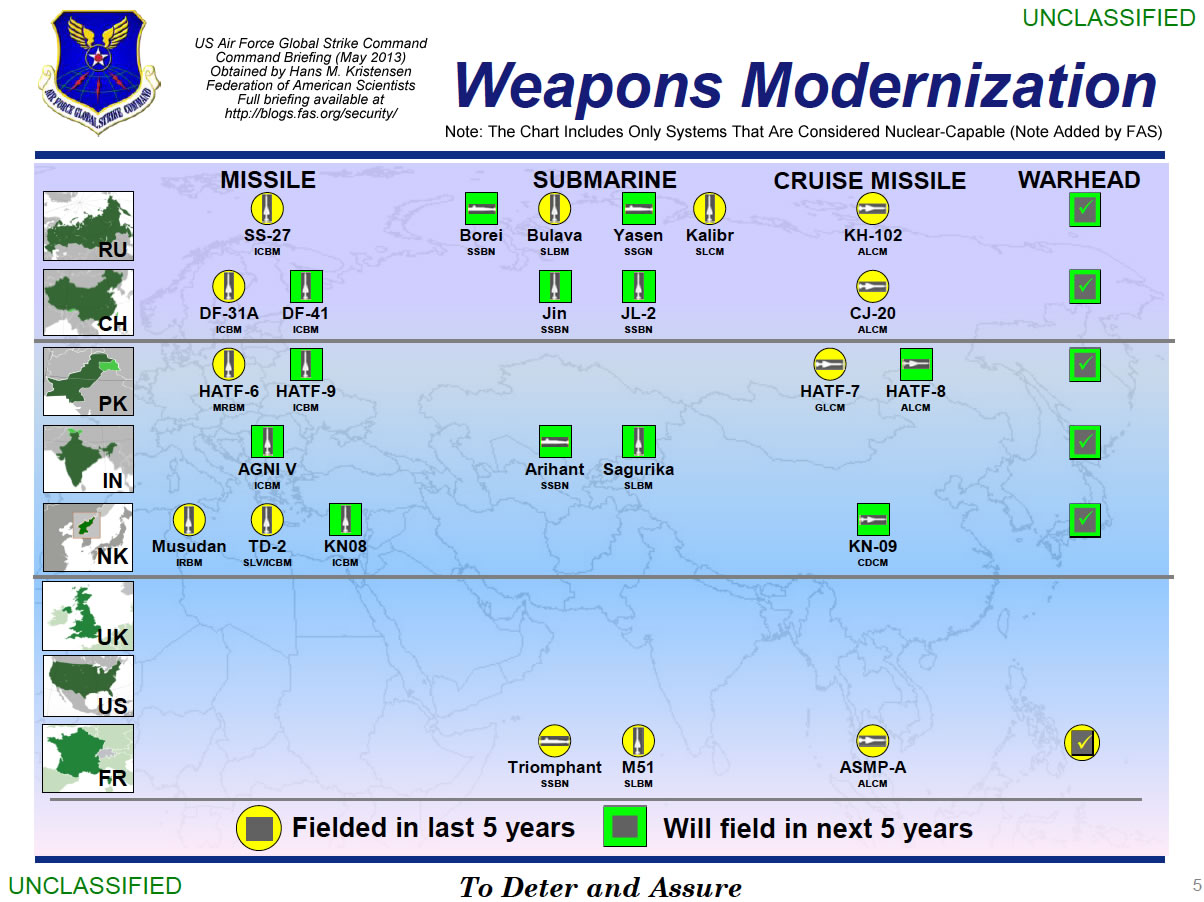
Click to view large version. Full briefing is here.
By Hans M. Kristensen
China and North Korea are developing nuclear-capable cruise missiles, according to U.S. Air Force Global Strike Command (AFGSC).
The new Chinese and North Korean systems appear on a slide in a Command Briefing that shows nuclear modernizations in eight of the world’s nine nuclear weapons states (Israel is not shown).
The Chinese missile is the CJ-20 air-launched cruise missile for delivery by the H-6 bomber. The North Korean missile is the KN-09 coastal-defense cruise missile. These weapons would, if for real, be important additions to the nuclear arsenals in Asia.
At the same time, a closer look at the characterization used for nuclear modernizations in the various countries shows generalizations, inconsistencies and mistakes that raise questions about the quality of the intelligence used for the briefing.
Moreover, the omission from the slide of any U.S. and British modernizations is highly misleading and glosses over past, current, and planned modernizations in those countries.
For some, the briefing is a sales pitch to get Congress to fund new U.S. nuclear weapons.
Overall, however, the rampant nuclear modernizations shown on the slide underscore the urgent need for the international community to increase its pressure on the nuclear weapon states to curtail their nuclear programs. And it calls upon the Obama administration to reenergize its efforts to reduce the numbers and role of nuclear weapons.
Russia
![]()
The briefing lists seven Russian nuclear modernizations, all of which are well known and have been underway for many years. Fielded systems include SS-27 ICBM, Bulava SLBM, Kalibr SLCM, and KH-102 ALCM.
It is puzzling, however, that the briefing lists Bulava SLBM and Kalibr SLCM as fielded when their platforms (Borei SSBN and Yasen SSGN, respectively) are not. The first Borei SSBN officially entered service in January 2013.
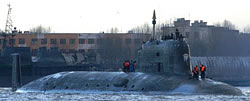
Nuclear Cruise Missile For Yasen SSGN
It is the first time I’ve seen a U.S. government publication stating that the non-strategic Kalibr land-attack SLCM is nuclear (in public the Kalibr is sometimes called Caliber). The first Yasen SSGN, the Severodvinsk, test launched the Kalibr in November 2012. The weapon will also be deployed on the Akula-class SSGN. The Kalibr SLCM, which is dual-capable, will probably replace the aging SS-N-21, which is not. There are no other Russian non-strategic nuclear systems listed in the AFGSC briefing.
A new warhead is expected within the next five years, but since no new missile is listed the warhead must be for one of the existing weapons.
China
![]()
The briefing lists six Chinese nuclear modernizations: DF-31A ICBM, DF-41 ICBM, Jin SSBN, JL-2 SLBM, CJ-20 ALCM, and a new warhead.
The biggest surprise is the CJ-20 ALCM, which is the first time I have ever seen an official U.S. publication crediting a Chinese air-launched cruise missile with nuclear capability. The latest annual DOD report on Chinese military modernization does not do so.
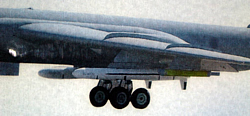
H-6 with CJ-20. Credit: Chinese Internet.
The CJ-20 is thought to be an air-launched version of the 1,500+ kilometer ground-launched CJ-10 (DH-10), which the Air Force in 2009 reported as “conventional or nuclear” (the AFGSC briefing does not list the CJ-10). The CJ-20 apparently is being developed for delivery by a modified version of the H-6 medium-range bomber (H-6K and/or H-6M) with increased range. DOD asserts that the H-6 using the CJ-20 ALCM in a land-attack mission would be able to target facilities all over Asia and Russia (east of the Urals) as well as Guam – that is, if it can slip through air defenses.
The elusive DF-41 ICBM is mentioned by name as expected within the next five years. References to a missile known as DF-41 has been seen on and off for the past two decades, but disappeared when the DF-31A appeared instead. The latest DOD report does not mention the DF-41 but states that, “China may also be developing a new road-mobile ICBM, possibly capable of carrying a multiple independently targetable reentry vehicle (MIRV).” (Emphasis added).
AFGSC also predicts that China will field a new nuclear warhead within the next five years. MIRV would probably require a new and smaller warhead but it could potentially also refer to the payload for the JL-2.
Pakistan
![]()
Pakistan is listed with five nuclear modernizations, all of which are well known: Hatf-8 (Shaheen II) MRBM, Hatf-9 (NASR) SRBM, Hatf-7 (Babur) GLCM, Hatf-8 (Ra’ad) ALCM, and a new warhead. Two of them (Hatf-8 and Hatf-7) are listed as fielded.
The briefing mistakenly identifies the Hatf-9 as an ICBM instead of what it actually is: a short-range (60 km) ballistic missile.
The new warhead might be for the Hatf-9.
India
![]()
India is listed with four nuclear modernizations, all of which are well known: Agni V ICBM, Arihant SSBN, “Sagurika” SLBM, and a new warhead. The U.S. Intelligence Community normally refers to “Sagurika” as Sagarika, which is known as K-15 in India.
Neither the Agni III nor Agni IV are listed in the briefing, which might indicate, if correct, that the two systems, both of which were test launched in 2012, are in fact technology development programs intended to develop the technology to field the Agni V.
The U.S. Intelligence Community asserts that the Agni V will be capable of carrying multiple warheads, as recently stated by an India defense industry official – a dangerous development that could well motivate China to deploy multiple warheads on some of its missiles and trigger a new round of nuclear competition between India and China.
The new warhead might be for the SLBM and/or for Agni V.
North Korea
![]()
North Korea is listed with five nuclear modernizations: Musudan IRBM, TD-2 SLV/ICBM, KN-08 ICBM, KN-09 CDCM, and a warhead.

The biggest surprise is that AFGSC asserts that the KN-09 is nuclear-capable. There are few public reports about this weapon, but the South Korean television station MBC reported in April that it has a range of 100-120 km. MBC showed KN-09 as a ballistic missile, but AFGSC lists it as a CDCM (Coastal Defense Cruise Missile).
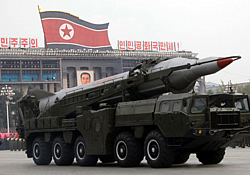
The Musudan IRBM is listed as “fielded” even though the missile, according to the U.S. Intelligence Community, has never been flight tested. In this case, “fielded” apparently means it has appeared but not that it is operational or necessarily deployed with the armed forces.
The Mushudan is listed as “fielded,” similar to the Russian SS-27, even though the North Korean missile has never been flight tested.
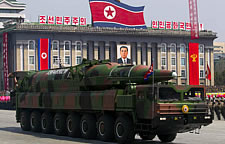
The KN-08 ICBM, which was displayed at the May 2012 parade, was widely seen by non-governmental analysts to be a mockup. But AFGSC obviously believes the weapon is real and expected to be “fielded” within the next five years. There were rumors in January 2013 that North Korea had started moving KN-08 launchers around the country at the beginning of a saber-rattling campaign that lasted through March.
Finally, the AFGSC briefing also predicts that North Korea will field a nuclear warhead within the next five year. Whether this refers to North Korea’s first weaponized warhead or newer types is unclear.
United Kingdom
![]()
The UK section does not include any weapons modernizations, which doesn’t quite capture what’s going on. For example, Britain is deploying the modified W76-1/Mk4A, which British officials have stated will increase the targeting capability of the Trident II D5 SLBM. Accordingly, a warhead icon has been added to the U.K. bar above.
Moreover, although the final approval has not been given yet, Britain is planning construction of a new SSBN to replace the current fleet of four Vanguard-class SSBNs. The missile section is under development in the United States. The new submarine will also receive the life-extended D5 SLBM.
United States
![]()
The U.S. section also does not show any nuclear modernizations, which glosses over important upgrades.
For example, the Minuteman III ICBM is in the final phases of a decade-long multi-billion dollar life-extension program that will extend the weapon to 2030. Privately, Air Force officials are joking that everything except the shell is new. Accordingly, a fielded ICBM icon has been added to the U.S. bar.
Moreover, full-scale production and deployment of the W76-1/Mk4A warhead on the Trident II D5 SLBM is underway. The combination of the new reentry body with the D5 increases the targeting capability of the weapon. Accordingly, a fielded warhead icon has been added to the U.S. bar.
In addition, from 2017 the U.S. Navy will begin deploying a modified life-extended version of the D5 SLBM (D5LE) on Ohio-class SSBNs. Production of the D5LE is currently underway, which will be “more accurate” and “provide flexibility to support new missions,” according to the navy and contractor. Accordingly, a forthcoming SLBM icon has been added to the U.S. bar.
Finally, the United States has begun design of a new SSBN class, a long-range bomber, a long-range cruise missile, a fighter-bomber, a guided standoff gravity bomb, and is studying a replacement-ICBM.
Hardly the dormant nuclear enterprise portrayed in the briefing.
France
![]()
France is listed with four nuclear modernizations, all well known: Triomphant SSBN, M51 SLBM, ASMP-A ALCM, and a new warhead.
The introduction of the ASMP-A is complete but the M51 SLBM is still replacing M45 SLBMs on the SSBN fleet.
The warhead section only appears to include the TNA warhead for the ASMP-A but ignores that France from 2015 will begin replacing the TN75 warhead on the M51 SLBM with the new TNO.
What is Meant by Nuclear and Fielded?
The AFGSC briefing is unclear and somewhat confusing about what constitutes a nuclear-capable weapon system and when it is considered “fielded.”
AFGSC confirmed to me that the slide only lists nuclear-capable weapon systems.
Air Force regulations are pretty specific about what constitutes a nuclear-capable unit. According to Air Force Instruction 13-503 regarding the Nuclear-Capable Unit Certification, Decertification and Restriction Program, a nuclear-capable unit is “a unit or an activity assigned responsibilities for employing, assembling, maintaining, transporting or storing war reserve (WR) nuclear weapons, their associated components and ancillary equipment.”
This is pretty straightforward when it comes to Russian weapons but much more dubious when describing North Korean systems. Russia is known to have developed miniaturized warheads and repeatedly test-flown them on missiles that are operationally deployed with the armed forces.
North Korea is a different matter. It is known to have detonated three nuclear test devices and test-launched some missiles, but that’s pretty much the extent of it. Despite its efforts and some worrisome progress, there is no public evidence that it has yet turned the nuclear devices into miniaturized warheads that are capable of being employed successfully by its ballistic or cruise missiles. Nor is there any public evidence that nuclear-armed missiles are operationally deployed with the armed forces.
Moreover, the U.S. Intelligence Community has recently issued strong statements that cast doubt on whether North Korea has yet mastered the technology to equip missile with nuclear warheads. James Clapper, the director of National Intelligence, testified before the Senate on April 18, 2013, that despite its efforts, “North Korea has not, however, fully developed, tested, or demonstrated the full range of capabilities necessary for a nuclear-armed missile.”
So how can the AFGSC briefing label North Korean ballistic missiles as nuclear-capable – and also conclude that the KN-09 cruise missile is nuclear-capable?
There are similar questions about the determination of when a weapon system is “fielded.” Does it mean it is fielded with the armed forces or simply that it has been seen? For example, how can a North Korean Musudan IRBM be considered fielded similarly to a Russia SS-27 ICBM?
Or how can the Musudan IRBM be identified as already “fielded” when it has not been flight tested and only displayed on parade, when the KN-08 is identified as not “fielded” even though it has also not been flight tested, also been displayed on parade, and even moved around North Korea?
Finally, how can the Russian Bulava SLBM and Kalibr SLCM be listed as “fielded” when their delivery platforms (Borei SSBN and Yasen SSGN, respectively) are listed as not fielded?
These inconsistencies cast doubt on the quality of the AFGSC briefing and whether it represents the conclusion of a coordinated Intelligence Community assessment, or simply is an effort to raise money in Congress for modernizing U.S. bombers and ICBMs.
Implications and Recommendations
There are still more than 17,000 nuclear weapons in the world and all the nuclear weapon states are busy maintaining and modernizing their arsenals. After Russia and the United States have insisted for decades that nuclear cruise missiles are essential for their security, the AFGSC briefing claims that China and North Korea are now trying to follow their lead.
For some, the AFGSC briefing will be (and probably already is) used to argue that nuclear threats against the United States and its allies are increasing and that Congress therefore should oppose further reductions of U.S. nuclear forces and instead approve modernizations of the remaining arsenal.
But Russia is not expanding its nuclear forces, the nuclear arsenals of China and Pakistan are much smaller than U.S. forces, and North Korea is in its infancy as a nuclear weapon state.
Instead, the rampant nuclear modernizations shown in the briefing symbolize struggling arms control and non-proliferation regimes that appear inadequate to turn the tide. They are being undercut by recommitments of a small group of nuclear weapon states to retain and improve nuclear forces for the indefinite future. The modernizations are partially being sustained by non-nuclear weapon states – often the very same who otherwise say they want nuclear disarmament – that insist on being protected by nuclear weapons.
The AFGSC briefing shows that there’s an urgent need for the international community to increase its pressure on the nuclear weapon states to curtail their nuclear programs. Especially limitations on MIRVed missiles are urgently needed. For its part, the Obama administration must reenergize its efforts to reduce the numbers and role of nuclear weapons.
There have been many nice speeches about reducing nuclear arsenals but too little progress on limiting the endless cycle of modernizations that sustain them.
Document: Air Force Global Strike Command Command Briefing
This publication was made possible by grants from the New-Land Foundation and Ploughshares Fund. The statements made and views expressed are solely the responsibility of the author.
War with Iran? Revisiting the Potentially Staggering Costs to the Global Economy
The Senate passage of Resolution 65 on May 22, 2013, some argue, draws the United States closer to military action against Iran. In October 2012, amid concerns that surprisingly little research addressed the potential broad outcomes of possible U.S.-led actions against Iran, researchers at the Federation of American Scientists (FAS) assembled nine renowned subject matter experts (SMEs) to investigate one underexplored question that now, eight months later, looms larger than ever: What are the potential effects on the global economy of U.S. actions against Iran? Collectively representing expertise in national security, economics, energy markets, and finance, the SMEs gathered for a one-day elicitation workshop to consider the global economic impacts of six hypothetical scenarios involving U.S.-led actions.
The elicitation revealed the rough effects of U.S. action against Iran on the global economy – measured only in the first three months of actualization – to range from total losses of approximately $60 billion on one end of the scale to more than $2 trillion to the world economy on the other end.
The results of the elicitation were compiled into the FAS report written by Charles P. Blair and Mark Jansson, “Sanctions, Military Strikes, and Other Potential Actions Against Iran.”
Summarized below are three of the six scenarios along with the associated estimated range of costs to the world economy in the first three months of U.S. action alone.
Scenario: Comprehensive Bombing Campaign (upper bounds of estimated costs to global economy: $1.7 trillion)
The president, not wanting to leave the job half-done and fearing that a more limited strike may not achieve all of its objectives or at too high a price should Iran retaliate, opts for a more thorough mission. The United States leads an ambitious air campaign that targets not only the nuclear facilities of concern but also seeks to limit Iran’s ability to retaliate by targeting its other military assets, including its air defenses, radar and aerial command and control facilities, and much of Iran’s direct retaliatory capabilities. These would include its main military bases, the main facilities of the Iranian Revolutionary Guard Corps (IRGC), and the Iranian Navy, Army, and Air Force. The United States seeks to ensure that the Strait of Hormuz remains open by targeting Iranian capabilities that may threaten it.
Scenario: Isolation and Persian Gulf Blockade – no military action (upper bounds of estimated costs to global economy: $550 billion)
Iran’s economy is reeling yet diplomatic agreement remains elusive. The United States, concerned that the Iranian regime has gone into survival mode, enacts what can be referred to as a “total cutoff” policy. The United States moves to curtail any exports of refined oil products, natural gas, energy equipment, and services. Investments in Iran’s energy sector are banned worldwide. Official trade credit guarantees are banned, as is international lending to Iran and investment in Iranian bonds. Insurance and reinsurance for all shipping going to and from Iran is prohibited. Substantial U.S. military assets are deployed to the Persian Gulf to block unauthorized shipments to and from Iran as well as to protect shipments of oil and other products through the Strait of Hormuz.
Scenario: Full-Scale Invasion (upper bounds of estimated costs to global economy: $2.8 trillion)
The United States resolves to invade, occupy, and disarm Iran. It carries out all of the above missions and goes “all in” to impose a more permanent solution by disarming the regime. Although the purpose of the mission is not explicitly regime change, the United States determines that the threat posed by Iran to Israel, neighboring states, and to freedom of shipping in the Strait of Hormuz cannot be tolerated any longer. It imposes a naval blockade and a no-fly zone as it systematically takes down Iran’s military bases and destroys its installations one by one. Large numbers of ground troops will be committed to the mission to get the job done.
Note: All opinions expressed here and in the report, as well as its findings, are those of the authors alone and do not necessarily reflect the views of the Federation of American Scientists or any of the participants in the elicitation that served as the centerpiece of this study.
Reflecting on NATO Security in the Context of a Rising China
The future promises to be far more challenging than the past for international security analysts. The security challenges that we will face will be increasingly complex, transnational, and interrelated. This will make their mitigation all the more difficult. But, the reality of this changing security landscape should not cause us to give pause and adopt a Pangloss-like outlook toward our present condition. Insecurity is not a given – security can always be made by those with the will and intellect to do so. In any given context, making security simply requires accurately identifying and prioritizing threats to international security and then developing the requisite mitigations. In this respect, the profession remains largely unchanged from its Cold War origins.
What has changed is the theoretical disposition of international security analysts. Our current generation is far more open to the theorization of security as an essentially contested concept. This has transformed the nature of the international security discourse. It now openly embraces the notion that security is tied to the social construction of security threats. It is therefore valid to intervene in the debate over how China’s rise affects international security from a social constructivist perspective. Doing so requires recognizing that security is subjective and only meaningful in the presence of a referent object. As a consequence, we must start our analysis with the question: “Whose security are we talking about?”
For the purpose of this article, the discussion will be restricted to NATO member states.
From this perspective, China’s rise is but one of many important variables in the post-Cold War international security discourse. In fact, China is not alone in terms of rising power and prestige. Other important countries include the other BRICSI countries – Brazil, Russia, India, South Africa, and Indonesia. Their collective rise is shifting the global balance of power away from the NATO region and forcing major structural changes to global and regional security architectures.
To avert a systemic breakdown, the resident and emerging major powers will need to reach a strategic compromise. This might even require the construction of a new order that better accommodates the rising powers’ interests without sacrificing too much of the incumbents’. But, reaching such a compromise will not be easy.
If the two sides find themselves unable to forge an amicable solution, one or more of the emerging powers could make a revisionist move. In the decades ahead, international security analysts must therefore remain attentive to any signals that the rising power(s) are no longer willing or able to accept the notion that “international peace is more important than any other national objective.” In the end, it is the possible rejection of the status quo by one or more of these emerging powers that most threatens international peace and stability.
But there is far more to the story of international security in the 21st Century than just the rise of these emerging powers. The world is also witnessing other major changes across multiple levels and units of analysis in the international security domain. Chief among these are the Nanotechnology, Biotechnology, Robotics and Information and Communication technologies (NBRIC) revolution, the rise of non-state security actors, the emergence of high-end non-traditional security (NTS) threats (such as climate change and emerging infectious disease), the advent of new high-end countermeasures (like ballistic missile defense), the increasingly irrelevance of the chemical and biological weapons non-proliferation regimes, the ongoing threat posed by North Korea, and the appearance of high-end, non-lethal, destructive weapon capabilities (cyber and EMP). Any of these could potentially destabilize the current status quo.
From the perspective of China, these changes present both opportunities and challenges. For example, the rise of non-state security actors presents a threat to the traditional state monopoly on violence. This certainly does not benefit an authoritarian government that can now be brought under surveillance (or even strategically challenged) by non-state actors. However, it also provides China with new export buyers for emerging technologies (such as cyber, precision manufacturing tools, drones, etc.) that could promote domestic economic growth while at the same time empowering others to undertake activities abroad that serendipitously benefit Chinese interests. For these reasons, NATO member states will be watching to see how China responds.
However, China is only part of the story. NATO member states must contend with the larger set of resident and emerging security challenges that threaten the status quo. This has led NATO member states (and many others) to securitize against a widening range of possible security threats to ostensibly protect their security. At times, this has included even partnering with China. But, the consequences of these moves are not all positive. Whereas individual securitizations may increase the security of one referent object (states), they can at the same time increase the insecurity of others (individuals). This state-human security dilemma is itself a major challenge for NATO.
In fact, according to a recent report, global democracy is now at a standstill. This is largely the result of the international community’s post-September 11th penchant for securitization. In the last decade, the transatlantic community has even witnessed major declines across a number of important democracy measures (such as freedom of the press) in key NATO member states and their allies. Efforts to counter the threat posed by NBRICs and traditional Chemical, Biological, Radiological and Nuclear (CBRNs) also threaten to undermine commercial innovation. This represents a serious challenge to NATO’s economic security in an age where the return to economic growth is necessary to pull Europe and North America out of the global recession.
These pose serious, although often overlooked, security challenges for NATO. The indirect effects of an increasingly securitized NATO might well lead to growing societal pressures within its member states to change course on certain national security policies. The failure by some governments to acquiesce to these calls for change in the name of security could further empower state and non-state actors to challenge the security policies of NATO member states. Not only would this undermine efforts to confront serious security issues abroad, but it could also lead to new security threats on the domestic front (like Anonymous).
Finding the right balance between security and civil liberties will be key for NATO. But, there is no certainty that its member states will be able to do so. If they cannot, NATO could be forced to contend with a growing domestic backlash against its securitizing moves. In that event, it would be even more difficult for NATO member states to counter a rising China. But, whether China could capitalize on such an opportunity is itself a matter of debate. To do so, China will need to overcome its own internal security challenges, which include declining economic growth, widespread environmental degradation, an aging population, and rising ethnic tensions – just to name a few.
So, what is the best path forward for NATO? The answer to this question hinges on the opening question to this article: “Whose security are we talking about?” This is a question that NATO needs to keep at the forefront as its member states respond to an increasingly complex international security landscape.
Michael Edward Walsh is the Director of the Emerging Technologies and High-End Threats Project at the Federation of American Scientists. He is also the President of the Pacific Islands Society, a Senior Fellow at the Center for Australian, New Zealand, and Pacific Studies of Georgetown University, and a non-resident WSD-Handa Fellow at Pacific Forum CSIS.
Building an Effective Nonproliferation Program: U.S. Support of IAEA Safeguards
To achieve our mutual goals of moving toward a world without nuclear weapons and expanding the peaceful use of nuclear energy globally, we must all give our financial, political, and technical support to a robust international safeguards regime. A growing international safeguards regime, capable of detecting diversion at known facilities and providing assurances regarding the absence of undeclared activities, is a condition for achieving disarmament and making the world safe for nuclear energy.
The United States is committed to providing the support that the IAEA needs through our Member State Support Program and the Department of Energy’s Next Generation Safeguards Initiative. These programs provide over $25 million per year in extra-budgetary and in-kind support to the Department of Safeguards.
–Secretary of Energy, Steven Chu, at the 2012 IAEA General Conference
A central pillar of international efforts to stem the spread of nuclear weapons is the International Atomic Energy Agency (IAEA) safeguards system. From the inception of the IAEA, the United States has supported the development and evolution of both the safeguards system itself and devices and systems approaches used by inspectors. The IAEA safeguards system comprises an extensive set of technical measures by which the IAEA Secretariat independently verifies the correctness and the completeness of the declarations made by States to the IAEA about their nuclear programs. From Iran to Syria, to the more than 190 other countries that accept IAEA safeguards, the IAEA safeguards system enhances international security, seeking to assure compliance with international nuclear agreements. The cornerstone of the global nonproliferation regime is the Treaty on the Non-proliferation of Nuclear Weapons (NPT). IAEA safeguards largely have evolved to ensure non-nuclear weapon state compliance with the NPT.
Because of the importance of the IAEA safeguards to international security and the facilitation of the peaceful uses of nuclear energy, the United States provides substantial assistance to the IAEA to improve the safeguards system. Much of this assistance is provided by US national laboratories and coordinated by the International Safeguards Support Office at Brookhaven National Laboratory. This article discusses the behind-the-scenes work of a network of U.S. Department of Energy national laboratories that support the IAEA and international safeguards.
The safeguards system is a complex verification system built on the reporting by States of their nuclear material inventories and on-site inspections conducted by the IAEA. The goal of the system is to enable the IAEA to verify that these accounts are “correct” – everything has been reported correctly – and “complete” – everything that should be reported has been – and, thus, the accounts represent the facts on the ground: “all present and accounted for.” The IAEA’s ability to do this with high confidence and to detect discrepancies in a timely manner is intended to deter States from diverting nuclear material and to sound the alarm promptly if States are not deterred.
An intrinsic tension exists between the pursuit of nuclear energy and the effort to prevent the illicit development of nuclear weapons – elements of the nuclear fuel cycle and nuclear material used to produce energy can also be used to produce nuclear weapons. For example, the enriched uranium that fuels most power reactors is produced in facilities that have the capability to produce uranium at the enrichment levels needed for nuclear weapons. Reprocessing of used reactor fuel assemblies proceeds in reprocessing plants whose output is separated plutonium in chemical and physical forms that are somewhat easily converted into the forms needed for nuclear weapons. Consequently, uranium enrichment plants and reprocessing plants are regarded as sensitive nuclear facilities.
This nuclear conundrum – the ability to use energy released from the atom as a weapon of war or as a tool for obtaining seemingly unbounded energy for powering homes, industry and development – was recognized at the dawn of the nuclear age. IAEA safeguards endeavor to make this conundrum manageable. On the one hand, IAEA safeguards can deter diversion of nuclear material from peaceful programs to nuclear weapon programs.
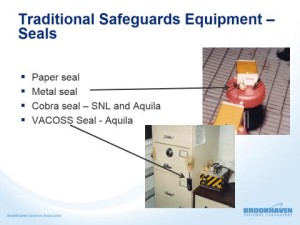
On the other hand, a positive conclusion by the IAEA of non-diversion can provide assurances to all countries in order to reduce regional and international tensions. The IAEA’s assurances allow States to engage in nuclear cooperation in medicine, agriculture and power with confidence that the materials and technology they supply will be used only for peaceful purposes. Thus, the IAEA safeguards system is intended to encourage peaceful uses of nuclear energy and, at the same time, inhibit nuclear proliferation.1
IAEA safeguards measures are diverse. For example, seals allow the IAEA to monitor access to States’ material or their own inspectors’ supplies while inspectors are absent from a facility. Seals are applied to material stores, reactor hatches and office cabinets where inspection equipment is stored. Seals are tamper indicating devices, meaning that if broken they indicate that an area has been accessed; they do not prevent access. Surveillance cameras are used in conjunction with seals to provide additional assurance of the lack of movement of materials within a facility or to verify that movements are related to scheduled operations. The foundation of nuclear material accountancy is a variety of destructive and nondestructive analysis techniques. These accountancy techniques provide qualitative and quantitative information regarding the composition of nuclear materials at a facility.
The IAEA Safeguards System has evolved over the past decades in response to new challenges. Traditionally, international safeguards were focused on inspections, nuclear material accountancy, and nuclear material measurements. After the first Gulf War in 1991, the IAEA Member States recognized the importance of enabling the IAEA to detect undeclared activities as well as confirm non-diversion of declared nuclear material.
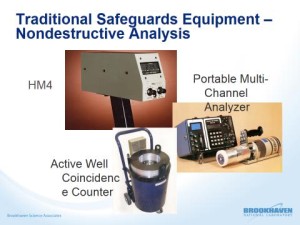
In 1993, the Member States began a program called 93+2, to enhance the IAEA’s safeguards capabilities and authorities. The results of this effort were a broad new set of inspection rights and techniques for the IAEA codified in a new legally binding document, the Additional Protocol to the Member State/IAEA Safeguards Agreement, and a host of new safeguards techniques.
The verification activities of the IAEA safeguards system would not be possible without international political and technical support over the decades to enhance the system, its technology and the training of its personnel and to accept the application of safeguards. Because of the intrusive nature of international safeguards, international political support for their use has been vital. Article III of the NPT lays out the obligation for States to accept international inspectors visiting their nuclear facilities. These inspections may take place on a periodic or even unannounced basis to deploy cameras, seals and measurement equipment to verify States’ declarations. This political support has been facilitated by a careful balance that is struck between the intrusiveness of the safeguards and their technical necessity to ensure verification is effective.
The IAEA’s budget (including the budget provided for international safeguards), is approved by its Member States. While all Member States value the IAEA’s nonproliferation role, some have economic concerns and programmatic interests that result in the IAEA’s safeguards budget being constrained to a level that is widely considered lower than necessary to fully carry out its mission. The IAEA’s 2014-2015 budget includes “unfunded activities” the IAEA is required to undertake that are not funded due to higher priorities. Because of its budgetary situation, the IAEA requires assistance from Member State Support Programs in order to ensure it has the tools and skilled manpower that it needs. This extra budgetary support is in excess of $30 million per year of which the U.S. provides roughly half.
The United States Support Program (USSP) was established in January 1977 to respond to urgent needs of the IAEA Department of Safeguards more quickly than could be met through the IAEA’s administrative procedures. Although it was originally intended as a short-term program, the program has continued because it has been successful in transferring technology from the U.S. national laboratories and commercial equipment suppliers.2 The USSP is supported by a network of national laboratories and private companies that perform the work requested by the IAEA and approved by the United States Government. The requests have included nondestructive and destructive analysis instrumentation and techniques, procedures and training, system studies, information technology, containment and surveillance, and management support. In addition, the USSP sponsors a small number of administrative tasks, involving subjects such as technical writing and quality assurance. The USSP assists the IAEA with three types of human resources support. First, the USSP provides cost-free experts (CFEs) to work for the IAEA Department of Safeguards on specific projects for two or more years. The CFEs are extra-budgetary positions where the salary and benefits are reimbursed by the United States. The USSP also provides the Safeguards Department with Junior Professional Officers (JPOs), who are given entry level positions to perform basic, yet essential, work and gain valuable professional and technical experience. Finally, the USSP sponsors a number of shorter-term consultants. Typically about 100 USSP tasks are active at any given time.
Since 1977, the USSP has contributed funding in excess of $300 million and has funded over 1200 tasks.3 The USSP has provided significant human resources support through 188 CFEs and 25 JPOs representing an accumulated 688 man-years of effort. The USSP largely draws its funding from the Program on Technical Assistance to IAEA Safeguards (POTAS) which is funded through an Act of Congress under the Nonproliferation, Anti-Terrorism, Demining and Related Programs (NADR) account of the U.S. Department of State. The NADR account includes the U.S. extra budgetary funding, called the U.S. Voluntary Contribution (USVC) to the IAEA. The USVC includes funding for safeguards, technical cooperation, nuclear safety and nuclear security. In addition to POTAS, the USVC provides funding for the analysis of environmental samples, commercially available safeguards equipment, infrastructure improvement projects, CFEs and JPOs in the non-safeguards departments of the IAEA, and other activities.
The USSP activities are sometimes complemented by funding through other U.S. programs, such as the State Department’s Nonproliferation and Disarmament Fund for special projects, and the National Nuclear Security Administration’s Next Generation Safeguards Initiative (NGSI). Over the years, the U.S. Department of Energy, the U.S. Nuclear Regulatory Commission, and the U.S. Department of Defense have also contributed in-kind support.
Brookhaven
The day-to-day management of the USSP occurs through the International Safeguards Project Office (ISPO) which is based at Brookhaven National Laboratory (BNL) and includes a liaison office in Vienna, Austria, in the IAEA section of the U.S. Mission to International Organizations in Vienna (UNVIE). Brookhaven offers a unique open national laboratory campus outside of New York City with a 60-year history of science-based work related to U.S. arms control and nonproliferation goals. Brookhaven’s distinguished reputation in international safeguards precedes the establishment of the USSP.
One of ten national laboratories overseen and primarily funded by the Office of Science of the U.S. Department of Energy (DOE), Brookhaven National Laboratory conducts research in the physical, biomedical, and environmental sciences, as well as in energy technologies and national security. Brookhaven also builds and operates major scientific facilities available to university, industry and government researchers. Brookhaven is operated and managed for DOE’s Office of Science by Brookhaven Science Associates, a limited-liability company founded by the Research Foundation of the State University of New York on behalf of Stony Brook University, the largest academic user of Laboratory facilities, and Battelle, a nonprofit, applied science and technology organization.
In the 1960s, the Atomic Energy Commission selected Brookhaven to develop international safeguards principles. Brookhaven’s Technical Support Organization (TSO) became the home for many technical experts who developed their own reputations in the field through domestic safeguards activities with the U.S. Nuclear Regulatory Commission, AEC, DOE, tours of duty with the IAEA, and work on international safeguards projects funded by U.S. government agencies. It was Dr. Herbert Kouts, then the head of TSO, who originally proposed the concept of the USSP to U.S. government contacts in the mid-1970s.
In the early years of the USSP, BNL scientists and engineers designed a hand-held device called the Portable Multi-channel Analyzer that was eventually deployed by the IAEA for simple nuclear material measurements. This instrument became the workhorse for IAEA safeguards for many years until recently when it was replaced by more modern, advanced instruments. Recently, BNL experts have become involved in NNSA’s NGSI and assist the IAEA with technology development, concepts and approaches, policy, human capital development projects, and outreach to other Member States. According to Dr. Doon Gibbs, Brookhaven’s Laboratory Director, “Support for the IAEA safeguards system is one of the most important activities the lab pursues. We are a science laboratory with a long tradition of supporting national security efforts, and we are very proud of the work we have done in this area for decades.”
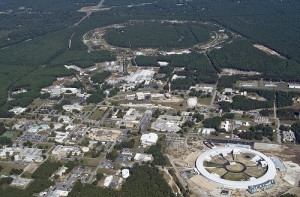
The central campus of Brookhaven National Laboratory. The National Synchrotron Light Source II, under construction at the time of this photo, is at bottom, right. The 3.8-kilometer circumference ring of the Relativistic Heavy Ion Collider can be seen in the distance at the top of the frame.
Over the last 15 years, BNL has become a safeguards training center, presenting courses for IAEA inspectors and Member States. BNL made use of its expertise in reactor design to develop a course on Design Information Verification of Research Reactors. This course teaches inspectors the safeguards significant attributes of research reactors and provides field exercises to help them practice associated skills. From about 1995 to 2001, the course was held at BNL and used its research reactors for facility tours. After a hiatus, the course was resurrected as a joint project with the Belgian Support Program, making use of expertise from BNL and facilities in Mol, Belgium. BNL won the honor of conducting a course on Additional Protocol/ Complementary Access4 for IAEA inspectors and has delivered the training at BNL since 2006. More recently, this training has been redesigned for delivery to IAEA Member States to teach them their responsibilities under the Additional Protocol. Brookhaven’s open campus makes it an excellent venue to host IAEA staff members and officials from other countries for training activities.

In addition, under the NGSI, Brookhaven has offered a course for the past five years that is intended to encourage qualified American and international students to enter the fields of safeguards and nonproliferation. The three-week course “Nuclear Non-proliferation, Safeguards and Security in the 21st Century,” is designed to give students a sound understanding of the foundations of the nuclear nonproliferation regime, the IAEA safeguards system, and U.S. efforts to meet emerging nuclear proliferation threats. In addition to lectures, the course includes exercises and demonstrations that take advantage of Brookhaven’s unique facilities. Above all, the course aims to give participants the knowledge, analytic tools, and motivation to contribute to improvement of the international nonproliferation regime.
In recent years, the USSP sponsored many tasks designed to assist the Agency in implementing the Additional Protocol, including programs in environmental monitoring, remote monitoring, and information technology. For the IAEA’s remote monitoring program, the USSP funded field trials for testing communication technologies such as telephone, Internet, and satellite. In addition, three engineers were sponsored as CFEs to help the IAEA develop its remote monitoring program, which is now operating effectively. Similar assistance was provided to help the IAEA establish the open source information collection and analysis program. Field trials and training were conducted for environmental sampling and, as a result, the IAEA was able to quickly implement its environmental sampling program. The USSP has traditionally provided significant support in enhancing the non-destructive analysis (NDA)5 and containment/ surveillance capabilities6 of the IAEA.
ISPO works with a network of national laboratories and numerous companies to meet the challenges facing the IAEA Department of Safeguards. For example, Los Alamos National Laboratory develops equipment and provides training in nondestructive analysis principles and implementation. Argonne National Laboratory provides training in export controls. Sandia National Laboratories has expertise in containment/surveillance, remote monitoring, and vulnerability assessments. Lawrence Livermore National Laboratory provides support in open source information and environmental sampling. Oak Ridge National Laboratory assists the IAEA with safeguards of enrichment technology. Companies working with ISPO include Aquila Technologies Group, Canberra Industries, and URS. The list of suppliers is long; the USSP is a national team effort.
“The United States Support Programme has played a key role through its R&D and implementation support activities in ensuring the IAEA safeguards system is able to continue to provide credible assurances that States are honouring their safeguards obligations, at a time of increasing verification challenges and resource limitations,” according to Jill Cooley, the IAEA’s Director for Concepts and Planning. The IAEA outlines its objectives in short-term, medium-term and long-term strategic and research and development plans. Its technical needs are documented in its biennial Development and Implementation Support Program.7
When the USSP was established, the U.S. government expected its $2.6 million investment to solve all the needs of the Department of Safeguards. In reality, the Department of Safeguards’ workload and need for support has increased as national interests in nuclear technology increase. In addition, as technology advances, so does the IAEA’s and Member States’ desire for better measurements and analysis. The Development and Implementation Support Program of the IAEA lists 24 projects for which the IAEA needs extra budgetary assistance. Despite having access to the extra budgetary resources of 21 Member State Support Programs, the IAEA’s technical needs outpace its resources.
Figure 1: U.S. Voluntary Contribution to the International Atomic Energy Agency
Because of the strong U.S. support for IAEA safeguards, the USVC portion for safeguards has increased substantially over the years. For example, Figure 1 shows an increase in total funding for the program over the past decade of 60%. At the same time, increasing security and economic concerns compete with and draw resources away from the IAEA and MSSPs. It is not clear in the current environment of decreasing budgets whether and how the IAEA can achieve the right balance in safeguard’s technical effectiveness and cost efficiencies. The USSP has been able to maintain its high level of support to the IAEA Department of Safeguards through increased efficiency by the USSP, prioritization of needs, and increases in other areas of the IAEA budget, such as direct support to large infrastructure projects.
The IAEA provides an important service to the world community in deterring the spread of nuclear weapons and enabling access for its Member States to the benefits of nuclear technology. The USSP, and other Member State Support Programs sponsored by countries around the globe, provide the IAEA with financial and technical resources that help it in its mission. Without these resources, the IAEA would not have obtained the advanced tools and developed the capabilities it needs to verify Member States’ compliance with the Nuclear Nonproliferation Treaty. Brookhaven National Laboratory is proud of its role in managing ISPO. There is still much work to be done and new challenges ahead. Brookhaven looks forward to assisting the U.S. government in future efforts to strengthen the effectiveness and improve the efficiency of safeguards.
Warren Stern is Senior Advisor in Brookhaven National Laboratory’s Nonproliferation and National Security Department. In 2010, he was appointed by President Obama to lead the Domestic Nuclear Detection Office at DHS and before that, Head of the IAEA’s Incident and Emergency Centre. He has also held a number of leadership positions at the U.S .Department of State, Arms Control and Disarmament Agency and CIA.
Susan Pepper is the Deputy Chair of the Nonproliferation and National Security Department at Brookhaven National Laboratory. She has been the Coordinator of the U.S. Support Program to IAEA Safeguards since 1996 and she was the Head of the International Safeguards Project Office at BNL from 1999 to 2011.
Chinese Nuclear Developments Described (and Omitted) by DOD Report
By Hans M. Kristensen
Going, going, gone! In its latest annual report to Congress on the military and security developments of the People’s Republic of China, the Pentagon has removed the last public authoritative overview of Chinese nuclear forces.
Until 2010, the annual reports included a table with a detailed breakdown of the different types of ballistic missiles that enabled the public to monitor the development of China’s nuclear modernization. In 2011, however, things began to change when a less detailed table was included that only showed overall categories of missiles. That version appeared in 2012 as well, but the 2013 report includes no table at all of China’s missile forces.
The tidbits of information left in the report indicate an ICBM force that is modernizing but leveling out and an SSBN force that is approaching functional capability.
Land-Based Nuclear Forces
DOD reports the same number of ICBMs as last year, 50-75. The Pentagon considers a missile with a range of at least 5,500 km to be an ICBM, so this number includes the DF-5A, DF-31A, DF-31 and DF-4. Of these, only the DF-5A and DF-31A can reach the continental United States.
The 50-75 ICBMs is the same number DOD has reported for the past three years, which indicates that the ICBM force level has leveled out for now. But DOD predicts that additional DF-31As will be deployed over the next two-three years.
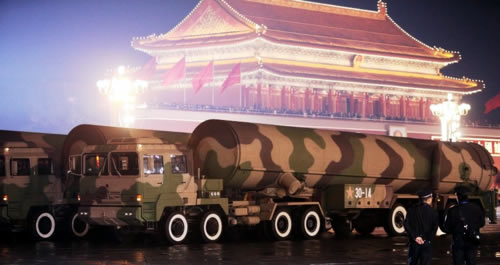
The report also repeats the prediction from previous years that China “may also be developing” a new road-mobile ICBM that is “possible capable of” carrying MIRVed warheads. The U.S. Intelligence Community has for several decades assessed that China has a capability to develop and deploy MIRV but that it has not yet done so. One sentence in the report comes close to saying that that’s about to change with “The new generation of mobile missiles, with warheads consisting of MIRVs and penetration aids,” but the report does not confirm widespread rumors (see here and here) that a 10-warhead DF-41 ICBM was test launched last year. All appeared to feed off this article. Many MIRV reports appear to confuse warheads with decoys and penetration aids.
The report does not provide an update of nuclear medium-range missiles, except confirming that a few aging liquid-fuel DF-3As are still operational. They will likely be retired within the next few years.
As one would imagine, the new and increasingly mobile missile force requires updating the command and control system. The DOD report states that China has done so and states that “improved communications links” means that “the ICBM units now have better access to battlefield information, uninterrupted communications connecting all command echelons, and the unit commanders are able to issue orders to multiple subordinates at once, instead of serially via voice commands.”
At the same time, further increases in the number of mobile ICBMs, the DOD report states, “will force the PLA to implement more sophisticated command and control systems and processes that safeguard the integrity of nuclear release authority for a larger, more dispersed force.”
Sea-Based Nuclear Forces
The DOD report states that China has added a third Jin-class (Type 094) SSBN to its fleet and that two more are in various stages of construction. Their nuclear ballistic missile, the Julang-2, is not yet operational, however, but the report indicates that has missile program has overcome technical difficulties, completed a series of successful testing in 2012, and appears ready to reach initial operational capability in 2013.
There is no confirmation of the rumor that the JL-2 has a capability to carry multiple warheads.
The single Xia-class (Type 92) SSBN that China built back in the early 1980s has never been fully operational. It is still afloat, moored at the Jianggezhuang naval base near Qingdao in the Shandong province. The boat will likely be retired, along with its Julang-1 SLBMs, once the Jin-class SSBNs become fully operational.
Moreover, the report predicts that China within the next decade might begin construction of a new class of SSBNs, known as the Type 096. If so, that suggests that the Jin-class design may not have been considered a success.

A Jin-class (top) ballistic missile submarine and Shang-class attack submarine are seen docked at the naval base near Longpo on Hainan Island in this DigitalGlobe/GoogleEarth satellite image from June 27, 2012. Jin-class SSBN were first seen at Hainan in February 2008.
Once fully operational, the DOD report states, SSBNs based at Hainan Island “would then be able to conduct nuclear deterrence patrols.” But now China will operate the SSBN fleet remains to be seen. It might begin to mimic deterrence patrols of other nuclear weapon states, but it seems unlikely that China will begin to deploy nuclear-armed missiles on its SSBNs under normal circumstance because the Central Military Commission is unlikely to hand over nuclear warheads to the armed forces unless in an emergency.
Moreover, Chinese SSBNs are relatively noisy (see graph below) and vulnerable to enemy anti-submarine capabilities, so it seems contrary to China’s core strategic objective of protecting its retaliatory nuclear capability to send some of it out to sea where it can be sunk by enemy attack submarines.
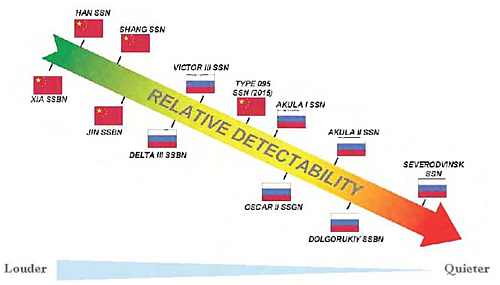
This vulnerability is compounded by the fact that Chinese SSBNs have never conducted a deterrence patrol (see below), which makes the Chinese navy woefully inexperienced in operating an SSBN effectively and safely.
Data obtained from U.S. Naval Intelligence under the Freedom of Information Act shows that Chinese missile submarines have never conducted a deterrent patrol. The attack submarine fleet is more active, with patrols having more than quadrupled over the past decade from around four per year to approximately eighteen patrols last year (see graph).
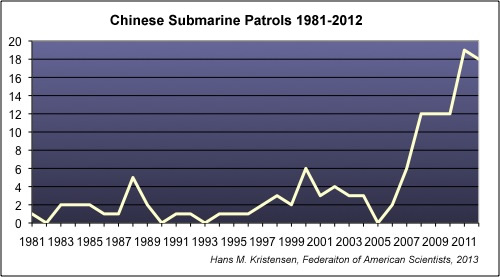
The increase in general-purpose submarine patrols has coincided with the introduction of the Chang-class (Type 093) nuclear-powered attack submarine (SSN) from 2005, but probably also reflects operations by more advanced diesel-electric submarines. The introduction of Type 093 SSNs has been slow, however, with only two in service and four improved version under construction to replace the remaining aging first-generation Han-class (Type 091) class SSNs.
Within the next decade, the DOD report predicts, China will likely begin construction of a new class of nuclear-powered attack submarines (Type 096), which might be equipped with land-attack cruise missiles.
Air-Based Nuclear Forces
The DOD report does not explicitly credit the Chinese air force with a nuclear capability but it probably has a limited secondary mission with nuclear gravity bombs. The H-6 medium-range bomber was used to carry out a dozen nuclear tests in the 1970s and 1980s.
The report states that China is modifying the H-6 to “a new variant that possesses greater range and will be armed with a long-range cruise missile.” Elsewhere the report states that H-6 upgrades “may provide the capability to carry new, longer-range cruise missiles.” So whether the H-6 upgrades involve one or more types of long-range cruise missiles is a little unclear.
So far the air-launched cruise missiles have not been credited with nuclear capability, although the ground-launched DH-10 (which is not mentioned in the DOD report) was described as “conventional or nuclear” by the Air Force National Air and Space Intelligence Center in 2009.
Conclusions and Implications
Chinese nuclear modernizations continue with modest pace with focus on safeguarding a retaliatory capability by replacing land-based liquid-fuel missiles with solid-fuel versions, increasing mobile ICBMs, and building a small fleet of ballistic missile submarines.
The size of the ICBM force appears to be leveling out for now, although more may be deployed in the future. And once the 36 JL-2 SLBMs on the three Jin-class SSBNs become operational, they will increase the Chinese nuclear ballistic missile force by approximately 27 percent compared with the current inventory.
Yet because older types are also being retired, the impact on the size of the total nuclear weapons stockpile so far appears to be modest. Earlier this year, Assistant Secretary of Defense for Global Affairs, Madelyn Creedon, testified before the Senate that despite China’s nuclear force modernizations, “we estimate that it has not substantially increased its nuclear warhead stockpile in the past year…” Moreover, STRATCOM Commander General Kehler last year rejected claims by some that China has hundreds or thousands more nuclear weapons than the “several hundred” estimated by the U.S. Intelligence Community.
The complete deletion of the table overview of China’s missile forces is striking because the Pentagon for years has been complaining about a lack of transparency in China’s military modernization. Ironically, this complaint was repeated when the Pentagon briefed this year’s report. Said Deputy Assistant Secretary of Defense for East Asia, David Helvey:
“So what – what concerns me – is the extent to which China’s military modernization occurs in – in the absence of the type of openness and transparency that others are certainly asking of China and the potential implications and consequences of that lack of transparency on the security calculations of others in the region. And so it’s that uncertainty, I think, that’s of greater concern.”
Instead of assisting Chinese nuclear secrecy, the United States should push for transparency and accountability. Authoritative overviews of Chinese nuclear force developments are important to enable the public to assess implications of China’s nuclear modernization and to counter attempts by those who use the uncertainty created by lack of information to hype the threat in order to justify excessive military spending.
This publication was made possible by grants from the New-Land Foundation and Ploughshares Fund. The statements made and views expressed are solely the responsibility of the author.
Talk At US Air Force Global Strike Command

Kristensen on the tarmac at Barksdale Air Force Base with the crew of the nuclear-capable B-52H bomber “Rolling Thunder” (61-019) from the 96th Bomb Squadron that recently flew B-52 bombers over South Korea.
By Hans M. Kristensen
Earlier this week I went to Barksdale AFB on an invitation from General Jim Kowalski at Air Force Global Strike Command to brief his Deterrence and Assurance Working Group.
Air Force Global Strike Command (AFGSC) is responsible for keeping U.S. strategic bombers (B-2 and B-52) and Intercontinental Ballistic Missiles (ICBMs) combat ready. One of two B-52H wings, the 2nd Bomb Wing, is based at Barksdale AFB, as is 8th Air Force Headquarters.
Barksdale AFB has a special history because it was there, in August 2007, that a B-52 arrived from Minot AFB with six nuclear-armed Advanced Cruise Missiles strapped under its wings without anyone knowing about it.
It was a great visit. The staff did a superb job hosting me, and Gen. Kowalski and his wife Julie were the most generous hosts. But they sure kept me busy:
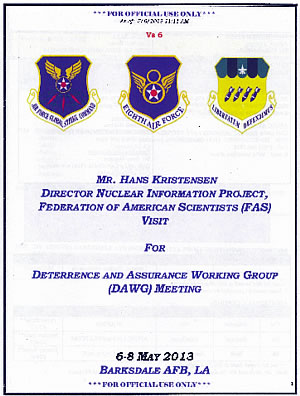
After getting woken up by the base bugle, I was brought to base headquarters for a one-on-one briefing by Gen. Kowalski on the mission of AFGSC. He told me about the capabilities of the command, the nuclear forces of the United States and other nuclear weapon states, nuclear modernization, as well as budget and costs issues.
After a swing by the base museum and a lunch with Gen. Kowalski and 18 members of the senior leadership, the General Larry Welch briefing room filled up with an additional 34 military and civilian officials for my talk.
In my talk I advocated further reductions of nuclear weapons, arguing that deterrence and assurance could be sustained at significantly lower levels. I pointed to the very different nuclear forces of different countries as examples of other countries ensuring their security with much smaller nuclear forces. And I predicted that new presidential guidance would probably reduce the force level further in the near future. Despite obvious disagreements, the discussion was courteous.
After the talk, they brought me out on the tarmac where the crew of a nuclear-capable B-52H from the 96th Bomb Squadron gave me a briefing and a tour of the inside. Its nuclear weapons are not stored at Barksdale AFB but up at Minot AFB. The 96th Bomb Squadron returned in April from a six-month deployment to Guam, during which some of the B-52Hs overflew the Korean Peninsula to deter North Korea and assure South Korea.
Next stop was the B-52 simulator where my co-pilot gave a few instructions, after which we powered up the six engines and took off, flew a brief tour over northern Louisiana, and returned to base (without crashing).
A cozy dinner in the beautiful home of Mr. and Mrs. Kowalski ended what had been an exciting visit with fascinating discussions with some of the men and women who operate America’s nuclear forces.
Download: Prepared remarks to U.S. Air For Global Strike Command Deterrence and Assurance Working Group
Russian SSBN Fleet: Modernizing But Not Sailing Much
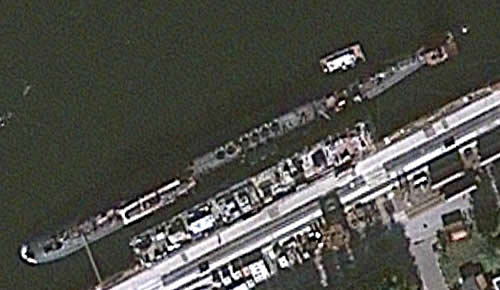
The second Borei-class SSBN (Alexander Nevsky) is fitting out at the Severodvinsk Naval Shipyard in northern Russia. Six of its 16 missile tubes are open on this August 2011 satellite image by DigitalGlobe/GoogleEarth.
By Hans M. Kristensen
The Russian ballistic missile submarine fleet is being modernized but conducting so few deterrent patrols that each submarine crew cannot be certain to get out of port even once a year.
During 2012, according to data obtained from U.S. Naval Intelligence under the Freedom of Information Act, the entire Russian fleet of nine ballistic missile submarines only sailed on five deterrent patrols.
The patrol level is barely enough to maintain one missile submarine on patrol at any given time.
The ballistic missile submarine force is in the middle of an important modernization. Over the next decade or so, all remaining Soviet-era ballistic missile submarines and their two types of sea-launched ballistic missiles will be replaced with a new submarine armed with a new missile (see also our latest Nuclear Notebook on Russian nuclear forces).
The new fleet will carry more nuclear warheads than the one it replaces, however, because the Russian military is trying to maintain parity with the larger U.S. nuclear arsenal.
Sluggish Deterrent Patrols
The operational tempo of the Russian SSBN fleet – measured in the number of deterrent patrol conducted each year – has declined significantly – actually plummeted – since the end of the Cold War.
At their peak in 1984 – the year after the Russian military became convinced that the NATO exercise Able Archer was in fact disguised preparations for a nuclear first strike against the Soviet Union, Russian SSBNs carried out 102 patrols. Under Mikhail Gorbachev, operations quickly declined in the second half of the 1980s. But even as the Warsaw Pact collapsed and the Berlin Wall fell in 1989, the fleet was able to muster a slight comeback in 1990.
As the Cold War officially ended in 1990, the Soviet Union dissolved and Russia descended into financial recession, the SSBN force increasingly stayed in port until in 2002, when no deterrent patrols were conducted all.
Since then, the performance has been a mixed bag. After a slight whiff of new life with 10 patrols in 2008 (up from 3 in 2007), the number of SSBN patrols has declined again to around five in 2012.
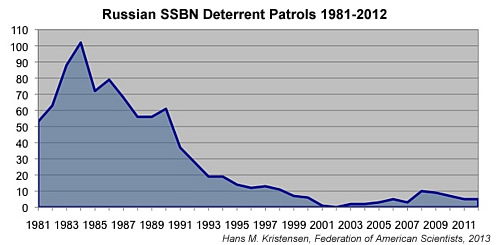
The recent decline contrasts with the Russian Navy’s declaration last year that it would resume continuous deterrent patrols from mid-2012. Assuming the five patrols occurred throughout the year and not just in the last six months, the fleet would have had a hard time maintaining a continuous at-sea presence with only five patrols. Theoretically, it could be done if each patrol lasted an average of 73 days. That is how long a U.S. SSBN deploys on a good day. But Russian SSBNs are thought to do shorter patrols, probably 40-60 days each, in which case most of the five patrols would have had to occur between July and December to maintain continuous patrol from mid-2012.
Even if the navy were able to squeeze a more or less continuous at-sea presence out of the five patrols, it would at best have consisted of a single SSBN – not much for a fleet of nine submarines or demonstrating a convincing secure retaliatory capability.
Perhaps more significantly, the five deterrent patrols conducted in 2012 are not enough for each SSBN in the fleet to be able to conduct even one patrol a year. The five patrols by nine SSBNs indicate that only five or less submarines are active. That means that submarine crews do not get much hands-on training in how to operate the SSBNs so they actually have a chance to survive and provide a secure retaliatory strike capability in a crisis. Crews probably compensate for this by practicing alert operations at pier-side at their bases.
Unlike U.S. SSBNs, which can patrol essentially with impunity in the open oceans, Russian deterrent patrols are thought to take place in “strategic bastions” relatively close to Russia where the SSBNs can be protected by the Russian navy against the U.S. and British attack submarines that probably occasionally monitor their potential targets.
The Russian navy remembers all too well the 1980s when the aggressive U.S. Maritime Strategy envisioned using attack submarines to hunt down and destroy Soviet SSBNs early on in a conflict, a highly controversial strategy [see here and here] that could likely have triggered escalation to strategic nuclear war. Hunting Russian SSBNs is no longer a primary mission for U.S. attack submarines, but it is probably still part of the mission package and one that Russian planners cannot afford to ignore. As a result, Russian SSBNs probably continue to patrol in the areas used in the late-1980s and early-1990s (see map) to provide maximum protection.
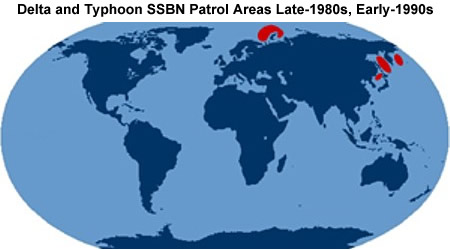
Force Structure
Russia currently operates 10 ballistic missile submarines (SSBNs), of which three Delta IIIs based in the Pacific are outdated and six Delta IVs based in the Barents Sea have recently been refurbished to serve for another decade or so. The 10th SSBN added in January 2013 is the first of a new type of Borei-class SSBNs that are scheduled to replace all Deltas by the mid/late-2020s.
The first Borei-class (Project 955) SSBN, Yuri Dolgoruki, entered service after more than 15 years of design and construction, marking the first time in 25 years that the Russian Navy had commissioned a new SSBN. A second Borei has been launched and a third is under construction. Russia has announced plans to build a total of eight Boreis. Each Borei is equipped with 16 SS-N-32 (Bulava) SLBMs, a missile that Russia has declared can carry up to six warheads.
The fourth and subsequent Borei-class SSBNs will be of an improved design, known as Borei-II or Project 955A). Russian news media is full of rumors that the improved Boreis will be equipped with 20 SLBMs instead of 16 on each of the first three boats. Some Russian officials dispute that, saying all Boreis will be equipped with 16 missiles.
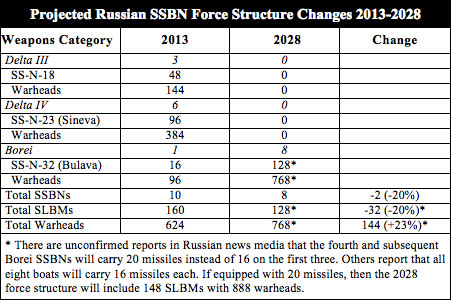
This force structure plan has implications for Russia’s nuclear posture and strategic priorities. The replacement of the Delta SSBNs with eight Borei SSBNs will reduce the size of the Russian SSBN fleet and the number of SLBMs, but result in a 23-percent increase in the number of sea-based warheads because the SS-N-32 carries more warheads than the SS-N-18 and SS-N-23 SLBMs it replaces.
In other words, Russia will be placing more eggs in fewer baskets at sea, which increases the importance of each SSBN – something strategists say is bad for crisis stability.
Conclusions and Implications
The Russian SSBN force is in the middle of a transition from Soviet-era weapons to a smaller but more warhead-heavy fleet of new submarines.
This means that the SSBN fleet will carry a growing portion of Russia’s strategic missile warheads – up from about a third today to nearly half by the mid-2020s.
The trend of increased warhead loading on sea-launched ballistic missiles is similar to the development on land where reduction of the Russian ICBM force will result in a greater portion of the remaining force being equipped with multiple warheads.
This is perhaps the most dominant trend of Russia’s nuclear forces today: fewer launchers but each carrying more warheads. Not that Russia will have more total nuclear warheads than before (their arsenal is declining), but that military planners have fallen for the temptation to place more nuclear eggs in each basket.
They appear to do so to compensate againt the larger U.S. nuclear missile force and its significant reserve of additional warheads. But it would be helpful if the Russian government would declare how many Borei-class SSBNs it plans to build in total and limit the number of missiles on each to 16.
The Russian modernization is motivating Cold Warriors in the U.S. Congress to argue that the United States should not reduce but modernize its nuclear forces. They are wrong for many reasons, not least because the two postures are very different.
The U.S. SSBN fleet is more modern with another 15 service years left in it, and it carries many more missiles that are much more reliable with more warheads. The U.S. could in fact easily reduce its SSBN fleet to ten boats, perhaps fewer.
Moreover, in contrast with U.S. SSBN operations, where each operational submarine conducts an average of 2-3 patrols each year, Russian SSBN crews do not get a lot of operational training with an average of less than one patrol per submarine per year.
Rather than opposing further reductions, U.S. lawmakers should support limitations on the growing asymmetry between U.S. and Russian strategic nuclear forces – an asymmetry that is significantly in the U.S. advantage – to help limit further concentration of nuclear warheads on Russia’s declining numbers of strategic missiles. That would actually help the national security interests of all.
See also: Russian nuclear forces, 2013
This publication was made possible by a grant from the Ploughshares Fund. The statements made and views expressed are solely the responsibility of the author.



